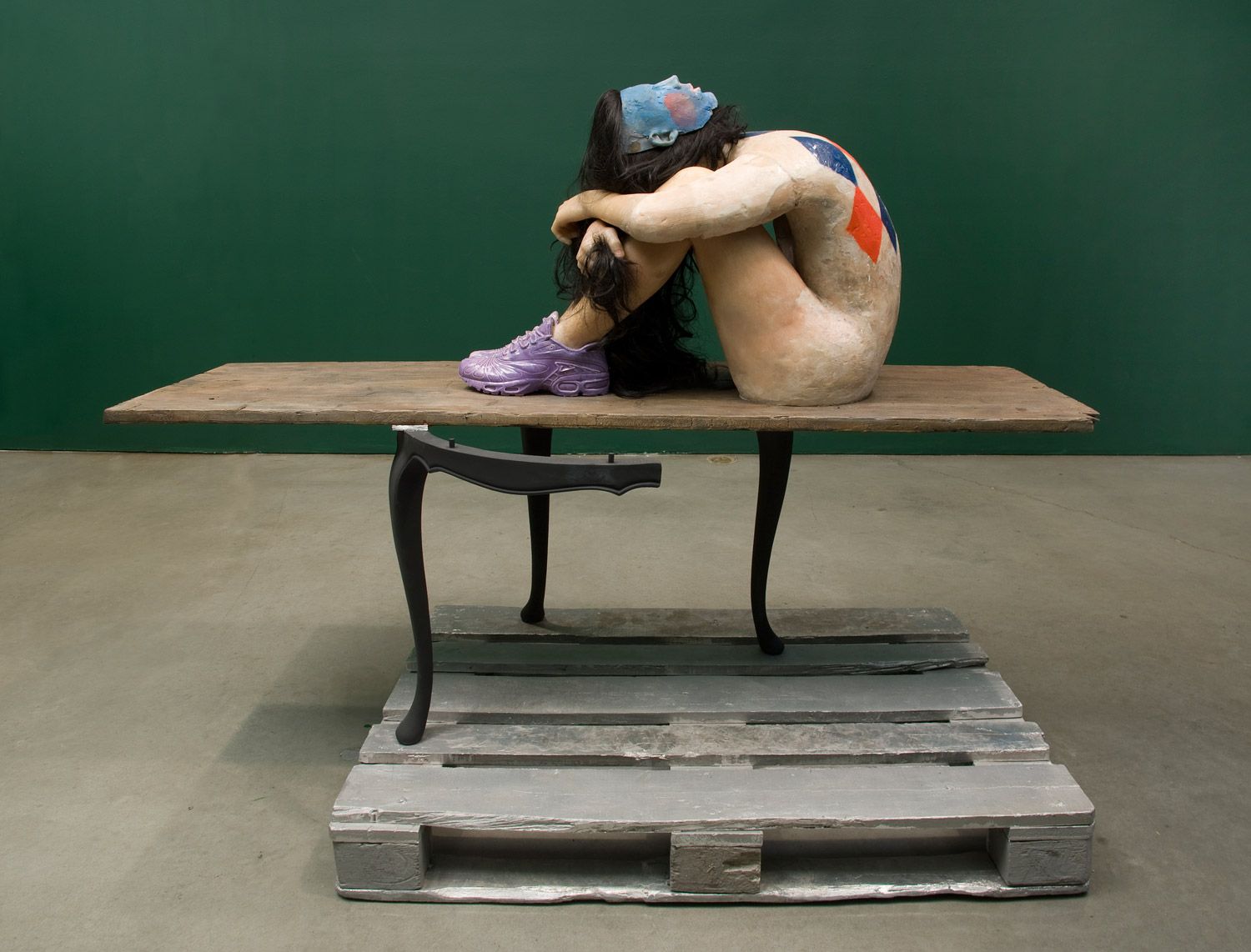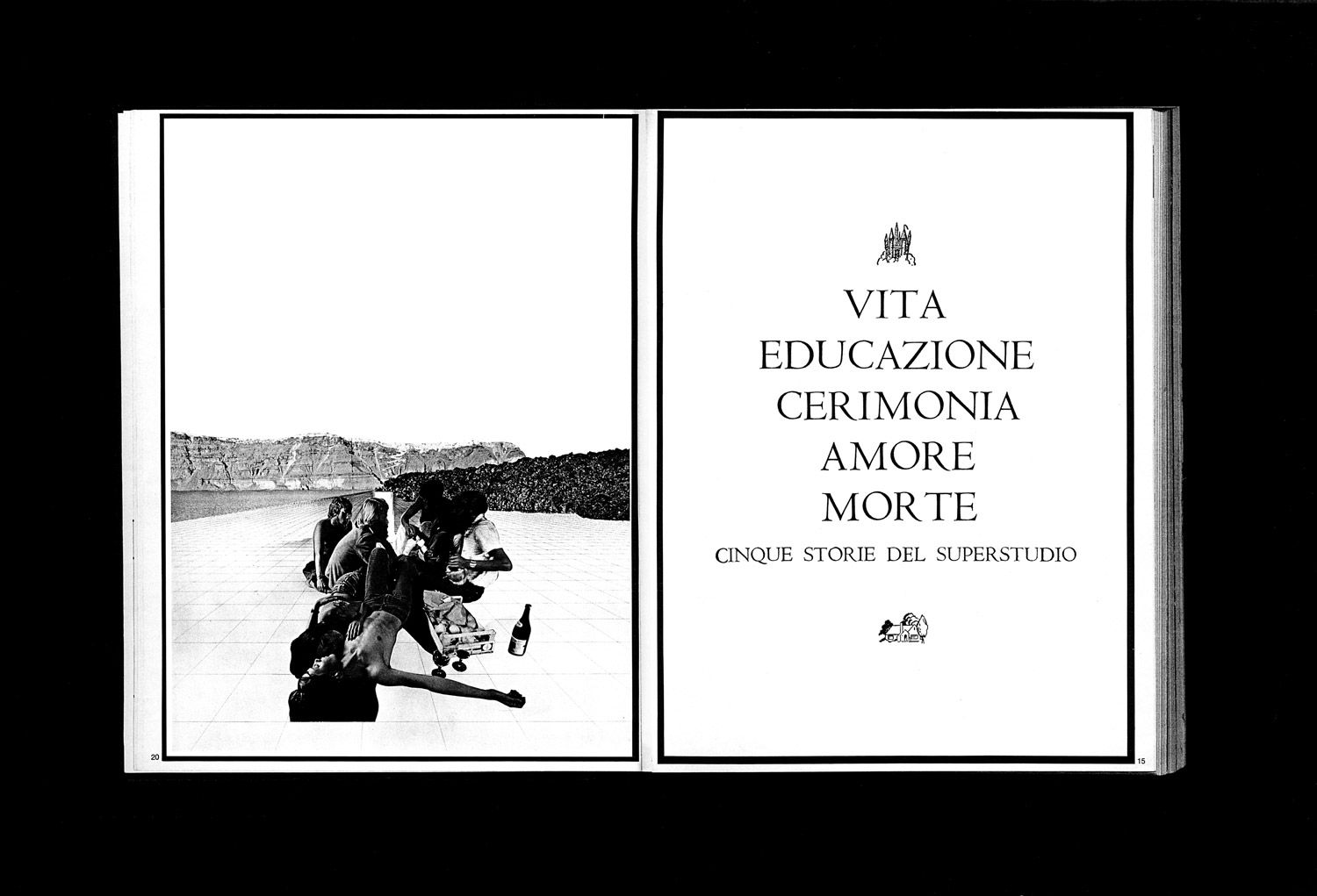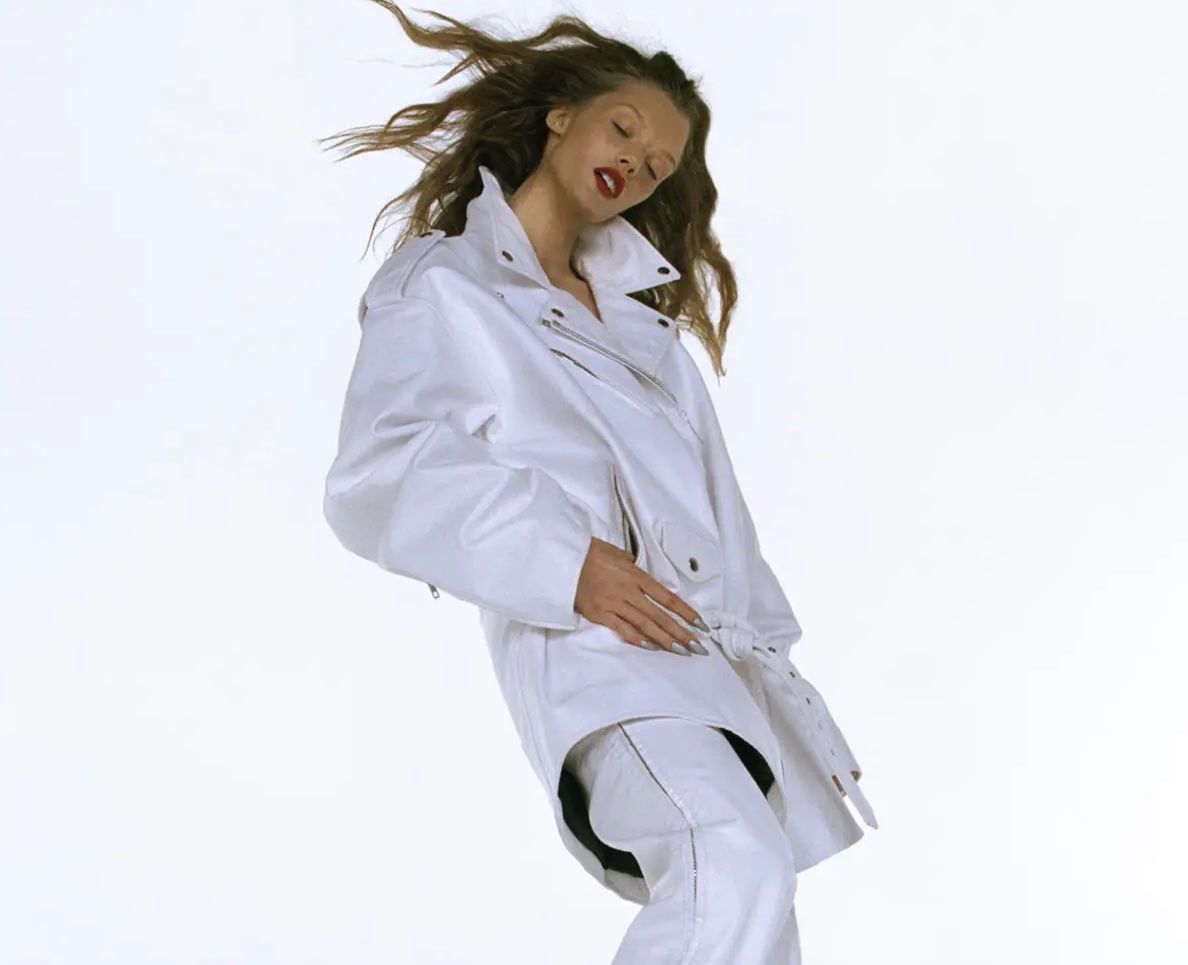NIKE: The Spirit Machine
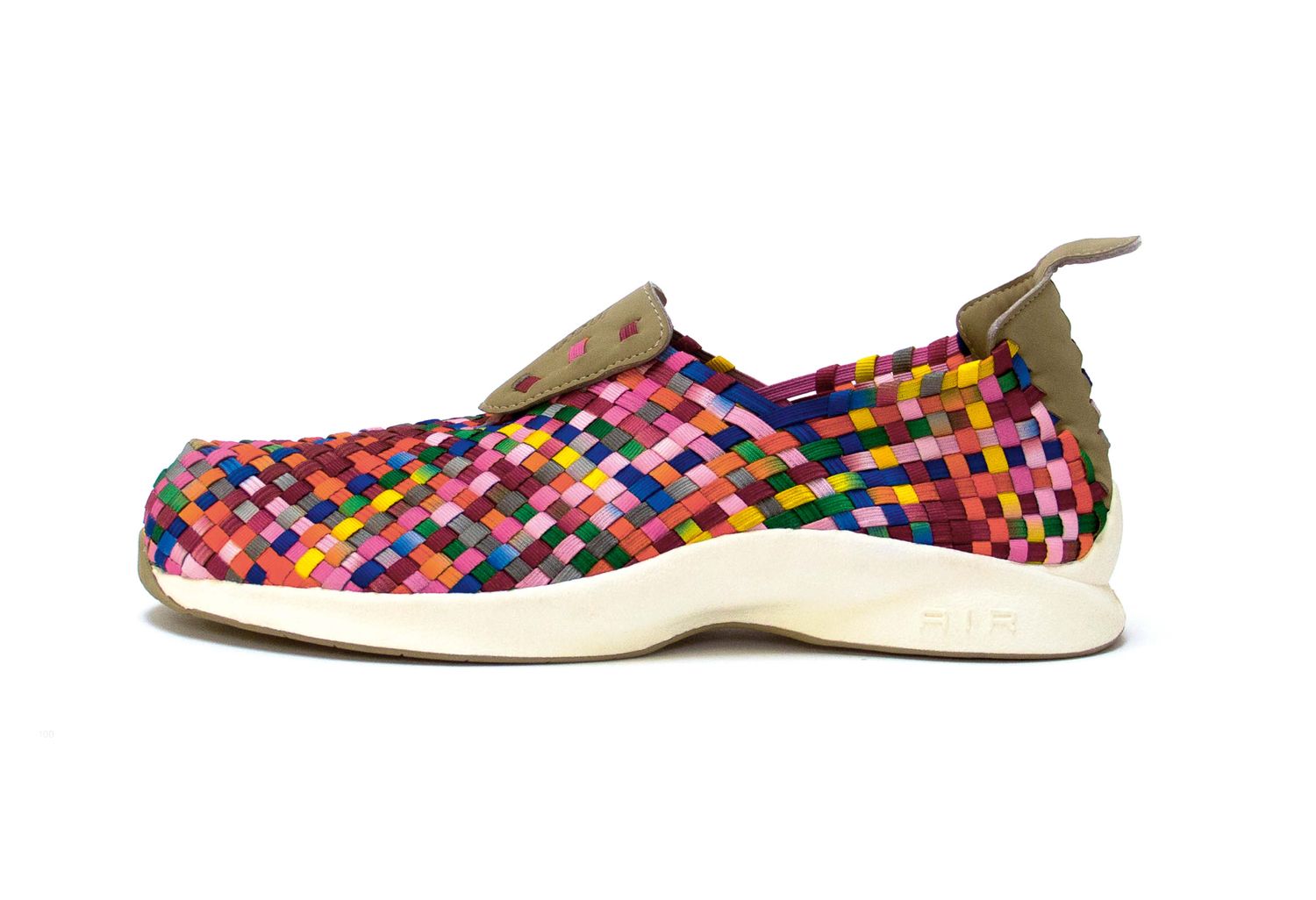
How does Nike avoid being a victim of its own success? The answer is HTM, a three-person design collaboration between CEO MARK PARKER, designer TINKER HATFIELD, and creative consultant HIROSHI FUJIWARA.
Nike Inc. is a multinational corporation based in Beaverton, Oregon, that employs more than 44,000 individuals in more than 160 countries. Newsweek once said Nike had incited a “new religion of brand consciousness,” while The Los Angeles Times claimed that the company was “so much a part of everyday culture in so many countries it’s frightening.” Since Mark Parker became CEO in 2006, Nike’s annual revenue is up 60 percent, profits have increased 57 percent, and its market cap has more than doubled. Yet Parker is anything but complacent: “One of my fears is being this big, slow, constipated, bureaucratic company that’s happy with its success,” he explained. So how does Nike avoid this, and continue growth in a meaningful and relevant way? The answer is HTM, a three-person design collaboration between designer Tinker Hatfield, creative consultant Hiroshi Fujiwara, and Parker himself, that functions as Nike’s core R&D team. HTM takes its initials from the first names of its members, and was formed in 2002 under the broad mission “to amplify new innovations, reinterpret existing designs, and explore concepts that take the brand to new places.” To date the trio has launched 17 widely varied limited-edition shoes. HTM is an unusual collaboration: it resides within a $26-billion company yet it operates without deadlines or budget constraints and is guided solely by the interests of its three members. Parker describes HTM as the company’s enema, and he believes it has the potential to change everything. On a pristine day in August I traveled to Nike’s headquarters to discuss the collaboration, its methods, and impact on the company and footwear design.
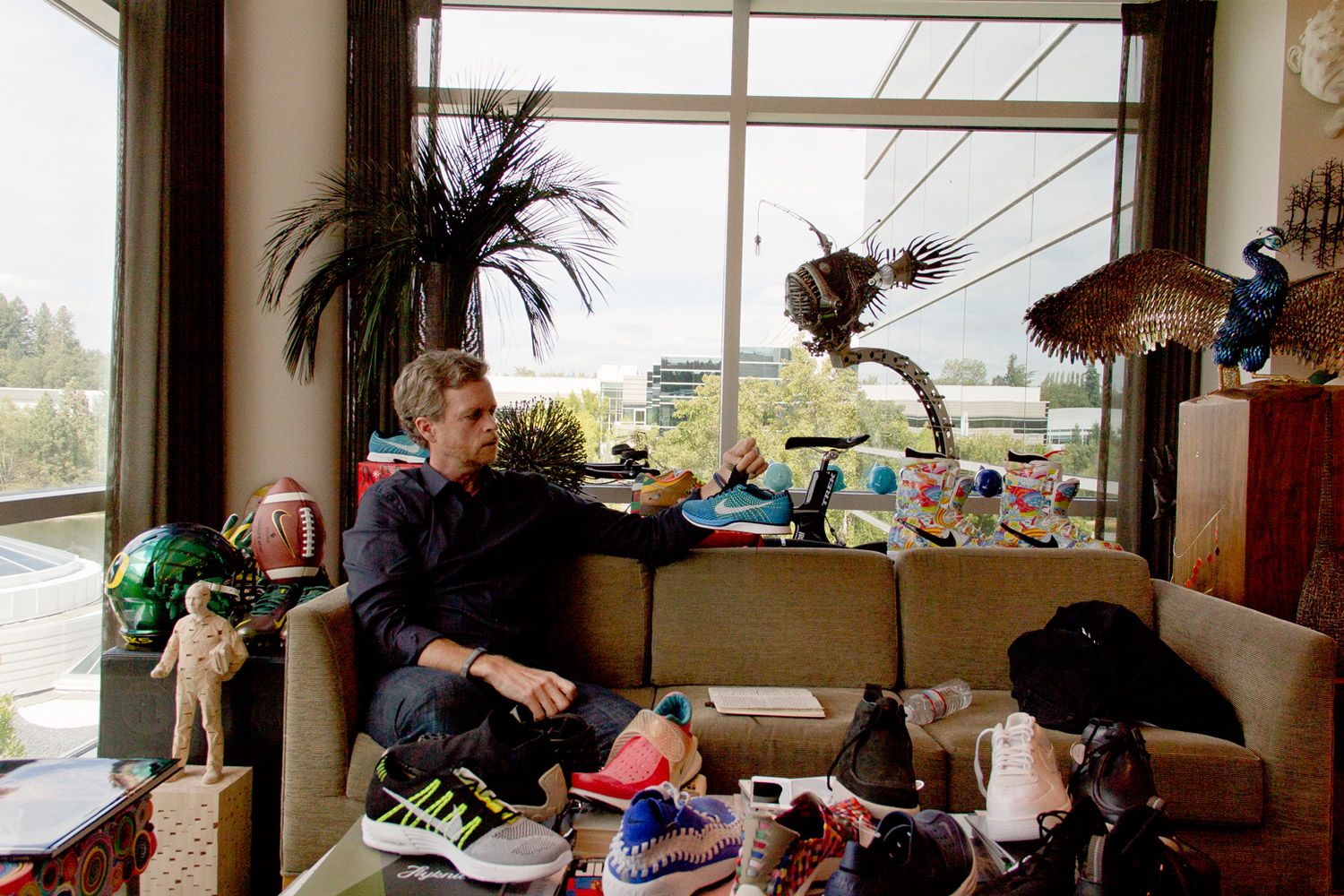
The Process
“Because everything seems to influence everything else.” Parker was explaining why Nike collaborates with so many diverse talents, including athletes, technologists, designers, and artists. Seated in his corner office, which is a dense and vividly colorful cabinet of curiosities – including an eerie bust of Abraham Lincoln moulded from a life mask, an astronaut’s manual from an Apollo mission, and one of Jimi Hendrix’s guitars – Parker continued, “Even people that have no experience in terms of what we do can come in with a completely fresh mind-set.” Seated opposite Parker was Tinker Hatfield, VP of Creative Concepts, and the man behind many Nike classics, including several Air Jordans and the Air Max 1. The coffee table between us was covered with HTM limited-edition models. Having such an inclination to collect and surround himself with culturally significant memorabilia, Parker is not a minimalist, but reductive design is paramount for HTM. “People think you need to add more things to create value,” he says. “It’s more challenging to take things out and only wind up with that which you really need.” The truth that very few of Nike’s meticulously engineered products will ever be used in the sporting arena isn’t overlooked by its designers. It’s estimated that only 20 percent of the trainers it sells are ever used for any form of exercise, and HTM is astutely aware that much of its success relies on its ability to penetrate popular culture as well as sports. “I have a personal interest in popular culture and the influence of culture on the consumer landscape,” says Parker. “We’re influenced by nature, music, art, technology, and yes, fashion design. Many interesting designs are made by intersecting or blending different influences.” Hatfield was quick to confirm the rumors that HTM is an informal affair: “It’s so casual that it can take its own course, we can be drawing and have stuff on the wall, or we might bring in somebody from sportswear who works on limited editions, and other times we’re sitting around at dinner, at restaurants, which has happened several times.” Parker elaborated, “That’s the beauty of it, there’s no pressure to fit some schedule, it happens when the impulse is there, and the ideas are flowing.” Fujiwara, who was absent from our discussion in Beaverton, says, “The best way to describe how Mark, Tinker, and I work collectively is through an organic approach.” While the group only meets a few times a year, the lax schedule doesn’t mean it isn’t serious. Their designs are inspired by, make use of, and accelerate Nike’s state-of-the-art manufacturing. The approach also relies on the 90 years of collective experience that exist between the three designers. Asked about the Nike resources at HTM’s disposal, Parker shrugs, “Whatever we need.” Parker often compares HTM to a musical collaborations, in which individual authorship is jettisoned for the collective whole, as sounds overlap and affect each other in immeasurable ways. While it is difficult, and may not necessarily be productive, to point out the hand of an individual author in an HTM shoe, Parker outlines the division of labor as follows: “Hiroshi comes from a more style standpoint whereas Tinker and I are more on the performance side of design and are less concerned with aesthetics. You can learn a lot from the blending of those different perspectives.”
The Lineup
After his undergraduate studies in Political Science at Penn State University, Parker began his career as a footwear designer in 1979 at a Nike R&D facility in Exeter, New Hampshire. Since then he’s worn many hats at the company, including General Manager and Vice President of Global Footwear, finally assuming the role of Chief Executive Officer in 2006. Parker speaks patiently and deliberately, “The mash-up, the charettes that we do, informally and formally, is a little bit like jazz improvisation, you riff a little bit here and there, and you get different ideas coming out of it that you wouldn’t normally get out of some more disciplined process.” He has excelled at assembling, nurturing, and leading the kind of unfettered collaboration that has made Nike so progressive in design and succesful in business. Hatfield is at home in Parker’s office, at one point he disappeared behind Parker’s desk in search of an old prototype, and jokingly called out, “I’m riffling through your priceless collection, without regard for anything.” Parker and Hatfield’s easy-going and modest demeanors belie the fact that these two Nike lifers have played a major hand in transforming the global footwear industry over the last three decades, ushering in one performance driven technology after another, and revolutionizing shoe aesthetics in the process.
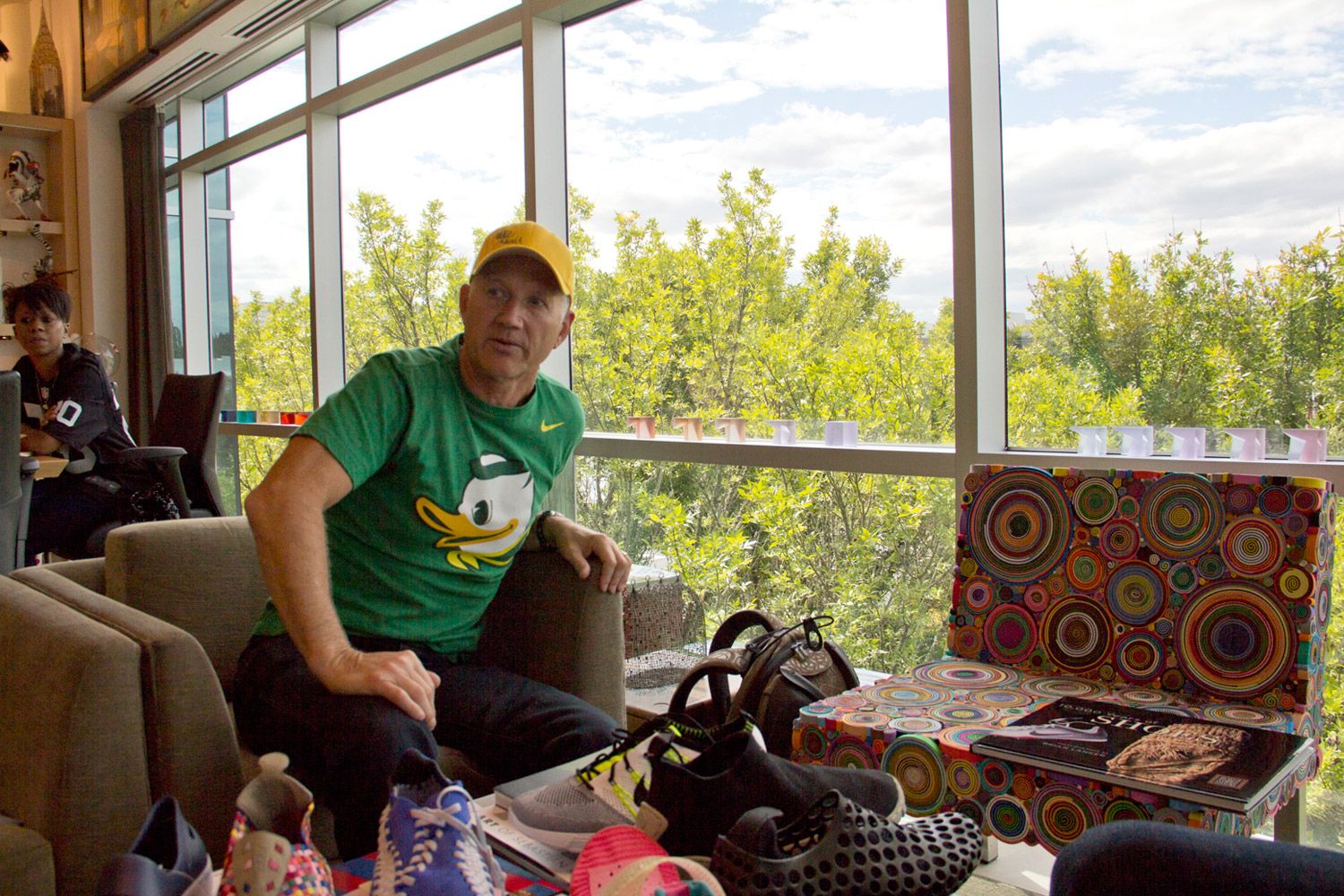
As an Architecture student at the University of Oregon, Hatfield was coached in track by Nike co-Founder Bill Bowerman. Then, in 1981, he joined Nike as a corporate architect of retail spaces and soon found himself translating his architectural approach to shoe design. The Nike Air Max, one of his early designs, was inspired by a visit he took to Renzo Piano’s Centre Pompidou. More than any building before it, the Centre Pompidou revealed its innards on its façade, and the Air Max 1 in turn exposed its own Air technology along the side of its sole. “The Air Max 1 was a performance shoe but I wanted to bring a storyline that would highlight the technology to people – to help people understand the new AIR technology used in the shoe. That shoe helped us understand how to sell a story and market our products,” Hatfield explains. Fujiwara spent his late teens and early twenties cross-pollinating the music, fashion, and street cultures of early 1980s Tokyo, London, and New York. Known as the mastermind of Harajuku, Fujiwara has been the backbone of a movement that goes much further than a commercial neighborhood of Tokyo. A protégé of Malcolm McLaren in the 80s, Fujiwara became an insurgent innovator of the post-punk and hip-hop cultures in Japan. He helped found fashion labels Undercover and A Bathing Ape, with Jun Takahashi and Nigo, respectively, while also popularizing brands like Stussy and, more recently, visvim. Fujiwara’s sensitivity to subtle changes across the cultural and aesthetic airwaves, which go undetected by most, keeps him at the forefront of a swath of activities in music production, fashion design, and branding, and busy working with clients like Starbucks, Levi’s, and A.P.C. When asked about how he decides to work with the people he does, Fujiwara explains, “It’s just a natural feeling. It always depends on timing. At the moment I feel like doing more with Nike, and HTM is the company’s pinnacle project with an important position to introduce opportunity into major places.”
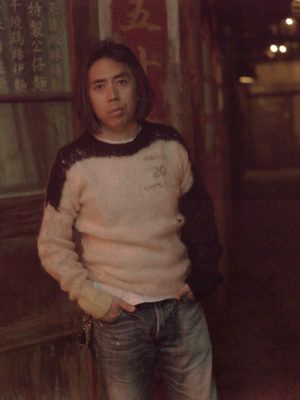
While Fujiwara’s work is highly visible, the man is most comfortable behind the scenes. Though he was physcially absent from our discussion, his personality and abilities seemed to linger in the room, perhaps from his last visit to Nike some three weeks prior. “I think he’s just a cool dude,” Hatfield stated enthusiastically, to which Parker adds, “Hiroshi’s style is very calm and thoughtful. He has a high level of sensitivity, particularly on an aesthetic level.”
The Situation
HTM is a highly personal project for its members. Parker even stated that “there is a practical value in the impact that HTM can have, but there is also a selfish creative outlet for all of us.” It’s clear that while Nike has reached the heights of corporate scale, design at the company has sustained itself as an intimate endeavor. As CEO, Parker’s involvement in HTM imbues the group’s work with clout and a sense of urgency, sending a clear message – that design is paramount – across the company. The intimate scale, fast pace, and connection to institutional memory is a design model that allows them to make impactful advancements within a colossal corporation. While the typical Nike sneaker is produced in a volume of 3,000 and distributed globally, HTM models are produced in as few as 60 units and sold at a handful of select shops. As a result there are fewer people involved in each HTM project, and Hatfield is brought back to his roots at Nike; “In the end HTM is awesome because it takes Mark and I both back to a different era when there weren’t so many people involved in the decision making process, even for big things. So we get to operate like we did maybe 30 years ago.”
“We get to operate like we did maybe 30 years ago.”
Limited editions have always been central Nike’s culture. In 1971, Nike co-founder Bill Bowerman made the first Nike sneaker in an edition of one. Bowerman made the sole by pouring rubber into a waffle iron, which moulded high-traction and lightweight treads. For the 1989 films Back to the Future and Batman, Nike made custom futuristic shoes for Michael J. Fox and Michael Keaton, respectively. Fox’s shoes hugged his feat with air pressure, not laces, and Keaton’s boots were inspired by Nike cross-training shoes. “In a sense, we’ve been doing HTM from the beginning, we just didn’t call it that,” says Hatfield, who was involved with both film projects.
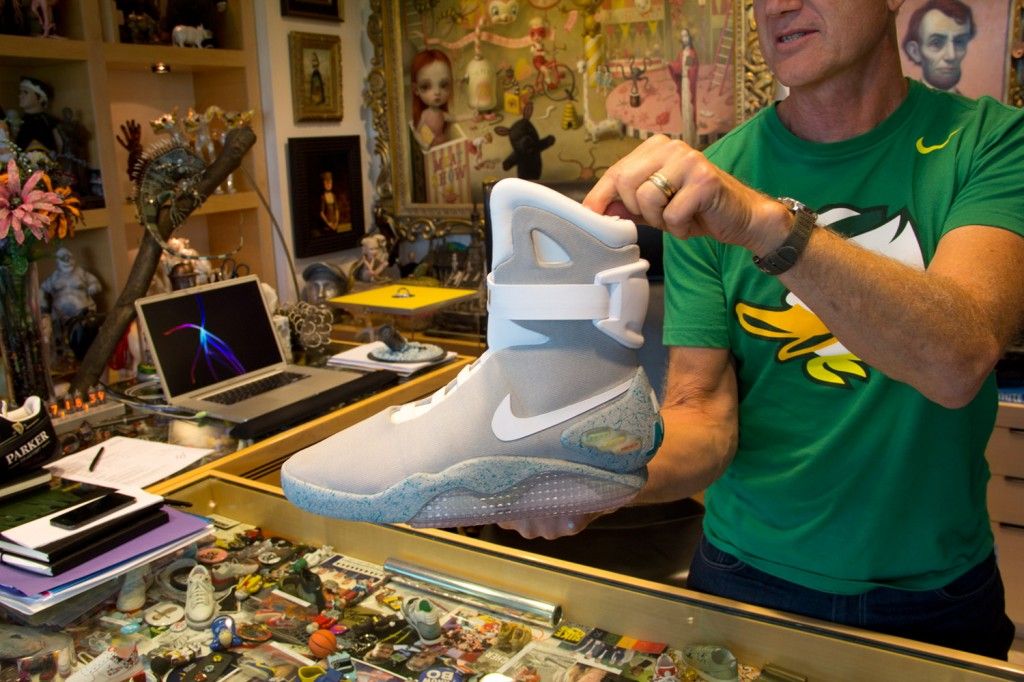
This flexibility in production is matched by HTM’s informal marketing strategy, which is entirely distinct from Nike’s emotional branding of heroism and athelete endorsements. HTM demonstrates the most composite example of the company’s more surgical and subtle marketing strategies. Writer Gary Warnett explains, “HTM could remain dormant to the outside world for a decade then make a return as if it never left, with no explanation and minimal marketing, which is refreshing today, when everything seems so keen to meet seasonal demand. In that way it’s kind of pure – there’s a chase and a willful awkwardness to getting a product, even though the end result is often very simple and accessible.” HTM’s indecipherable marketing is an important case in the dilemma of how to introduce street cred into the company’s vast size.
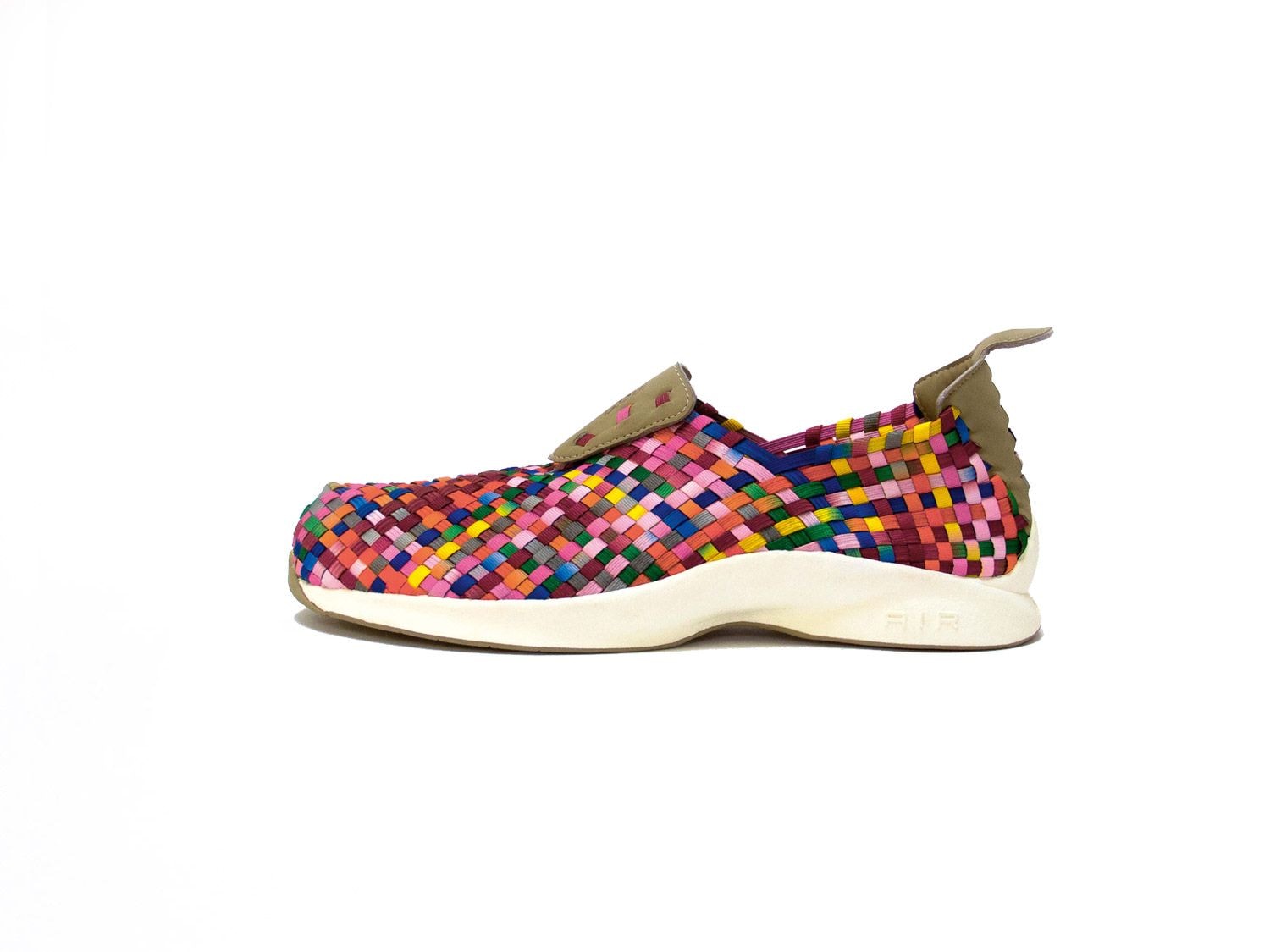
In the first decade of the 2000s the introduction of the Air Woven represented a new approach to business for Nike. Made for leisure rather than sports performance, the model's original run was handcrafted and sold in limited numbers at select accounts globally. Signaling an early moment of eBay and Yahoo auction hype for limited products, the Air Woven Rainbow was also an integral testing ground for HTM's introduction. This laceless oddity already looked like an intersection between traditionalism and the avant-garde, and when the HTM editions gave the shoe rainbow colors it pushed the boundaries even further of what an open-minded audience might embrace.
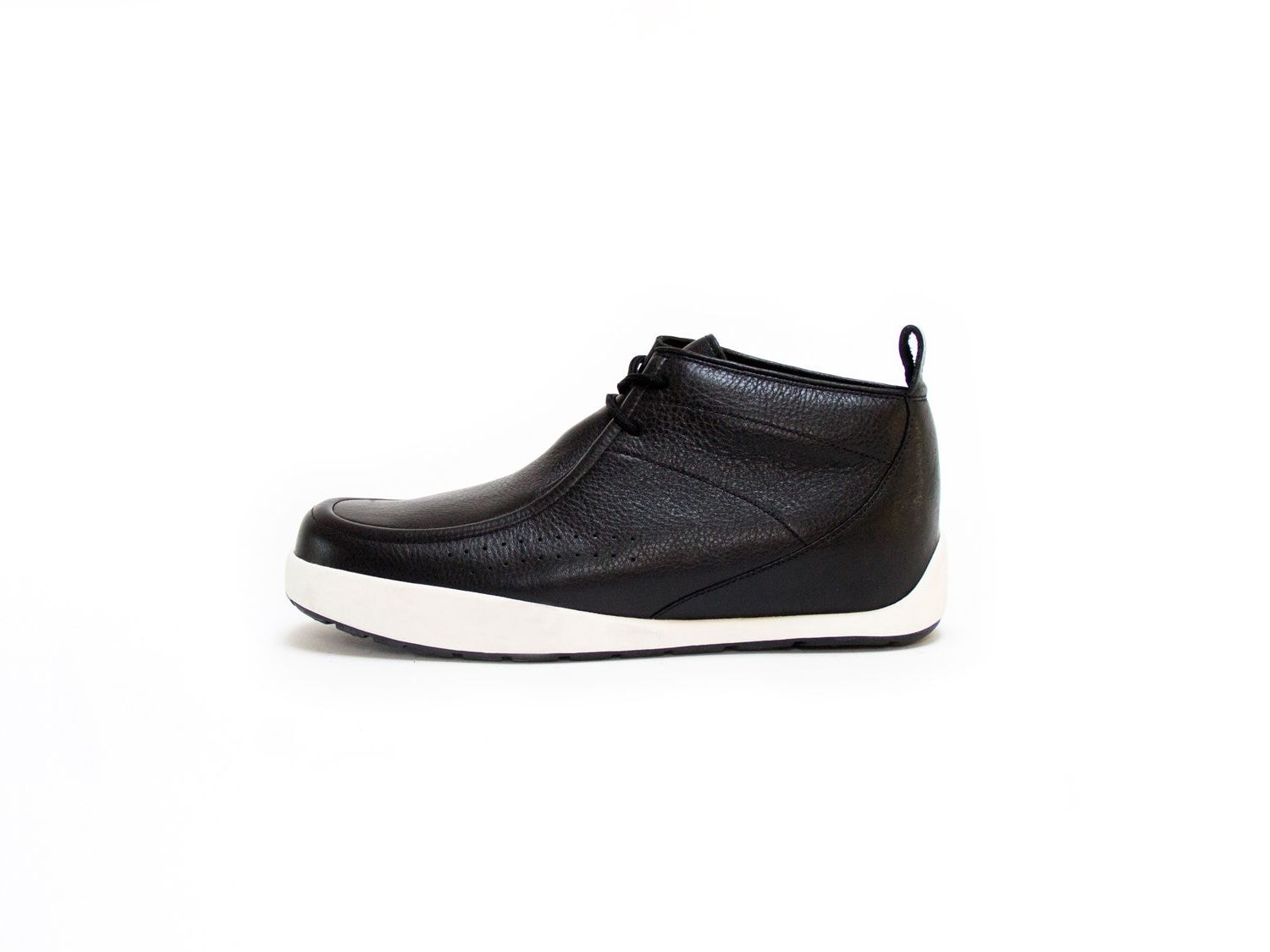
Back in the early 1980s, Nike released a line of casual shoes that was a commercial failure, but in a post-visvim world and with models like the Air Woven, which hint at an open-minded consumer, the Zoom Macropus made a little more sense. With the look of the 1960s Clarks Wallabee moctoe, the name Macropus is based on the family of marsupial species that includes the wallaby. With the edition numbers kept low, and the comfort afforded by the silver of Zoom Air cushioning, the Macropus was a successful entry into a boundary-blurring market.
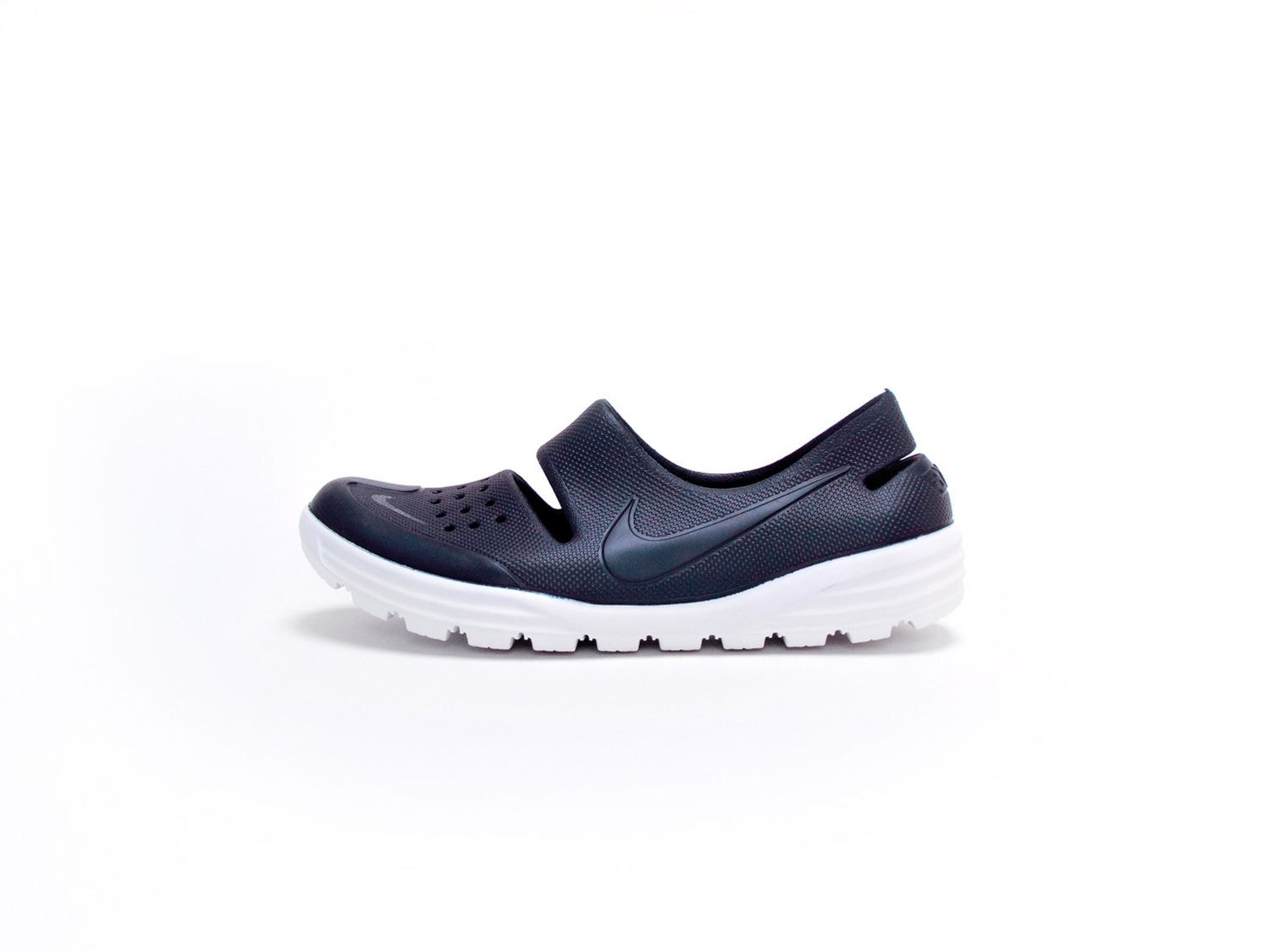
Western audiences tend to back off when it comes to stranger shoes, but in East Asia that conservatism seems less prevalent in the quest for comfort. That's why so many curious Nike designs have flourished in Japan over the years. The HTM Solar Soft Sandal's Croc-like looks, with an injection-molded upper and Lunarlite cushioning in the sole, never made it to shelves beyond Japan, China, and Hong Kong. The Solarsoft concept did however become the basis for several more models in recent seasons with warm weather wear and global distribution in mind.
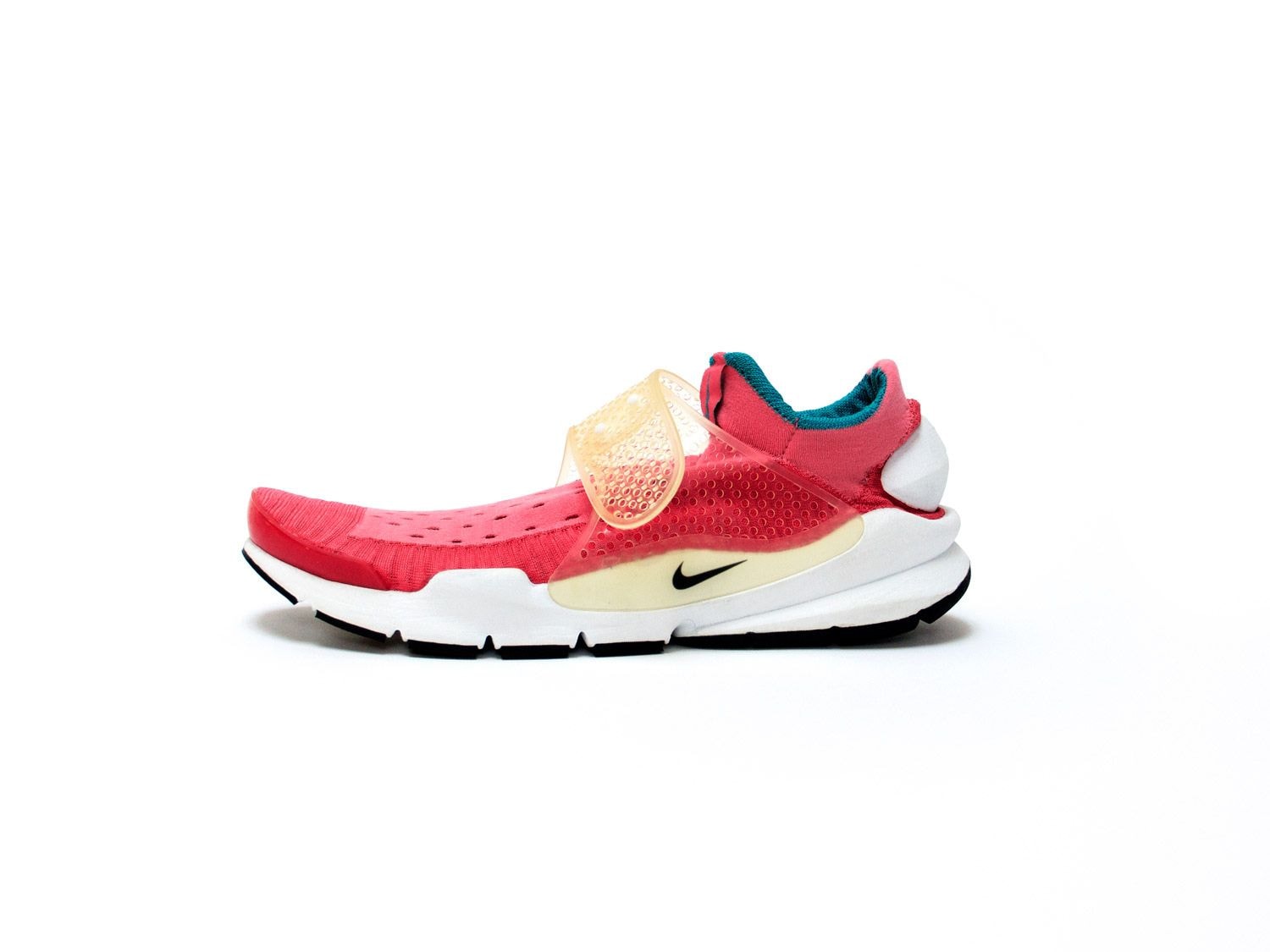
Technically the Sock Dart doesn't belong here, because it's not an HTM release. But all signs point to it being part of the family, including the strange casual merger of a sock and running shoe, the striking use of color, and of course its scarcity when it appeared in HTM doors. The Sock Dart's influence can be found in the first Nike+ collaboration with Apple, the Zoom Moire a couple of years later, plus a slew of current experiments in minimalism.
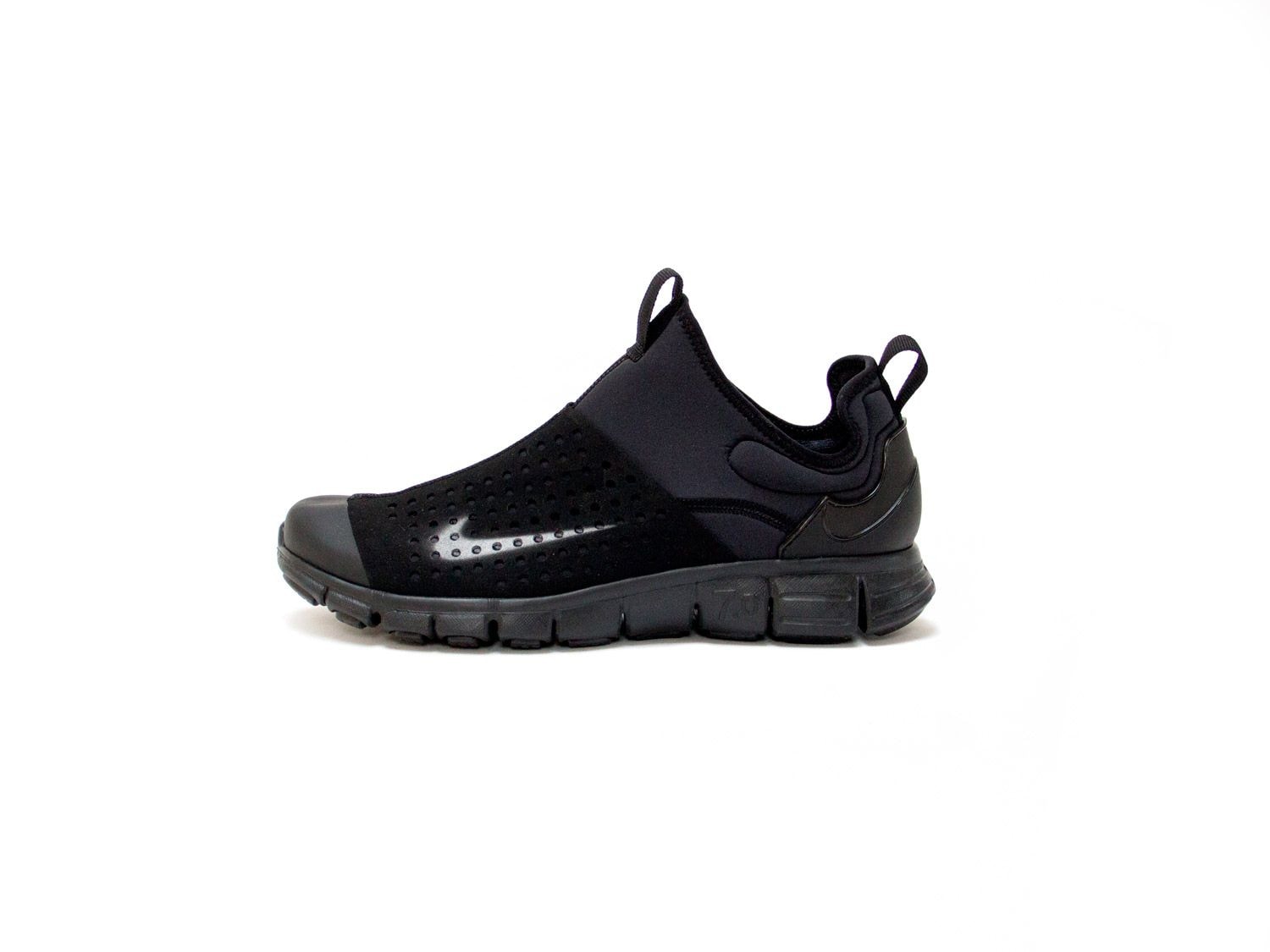
The HTM2 project turned the HTM line into a four-man team via the recruitment of another Mark – Mark Smith, a longtime Nike designer who moved from logos and branding into some ambitious and unique shoe design during his career with the company. Blending the Sock Dart DNA with the approach to natural motion of a Nike Free 7.0, the Runboot is visually ambitious. The stencil-like swoosh is an irreverent touch for a shoe that has a concept-car quality to it, making it feel like a sequel to the Presto Roam, with the benefits of eight more years of innovation.
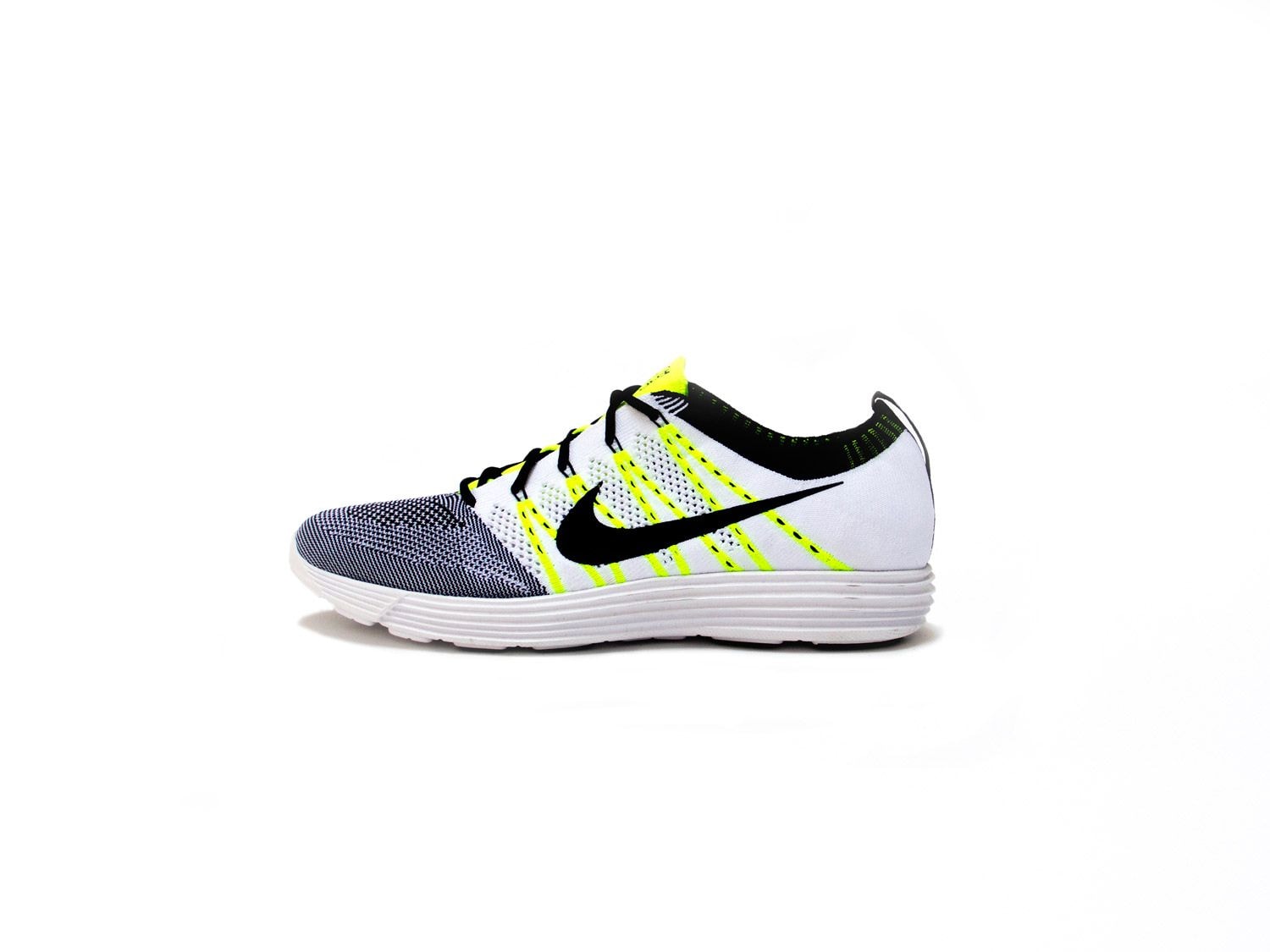
Accompanying the debut of the HTM Flyknit Racer, the Lunar Flyknit Trainer+ was a more accessible shoe in terms of fit and everyday comfort, and has remained an HTM-only release since early 2012. Applying the Flyknit Trainer's upper to a Lunarlon sole, it's a playground for patterns and color executions that's still capable of surprising an audience who think they've seen it all. The very first edition of this model – in white, Volt green, and black – had its number knitted into the tongue (similar to several original HTM releases). Its run was limited to just 100 pairs, which disappeared from a scattering of shelves instantly.
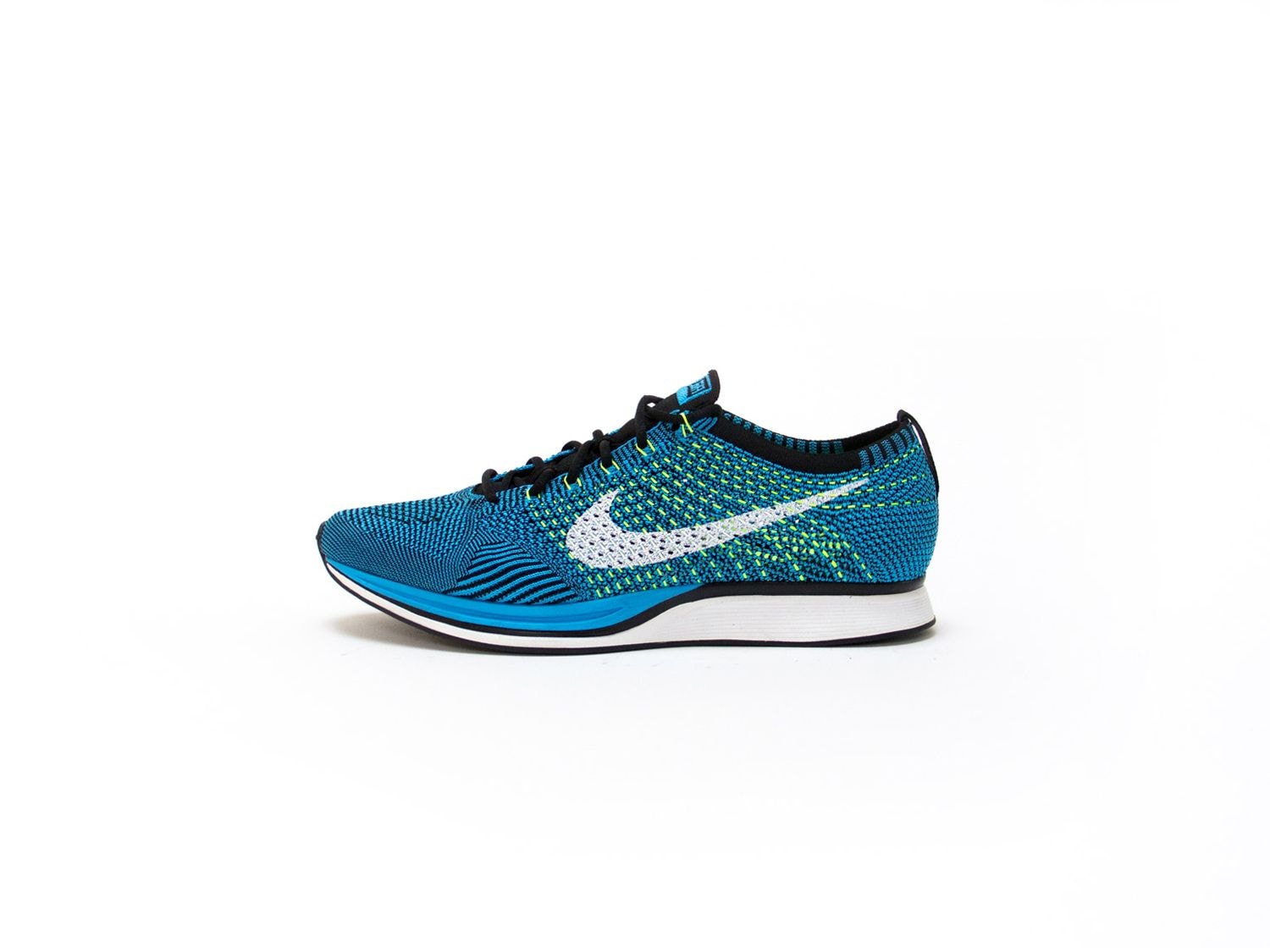
Setting off from HTM's first decade, this was an indicator as to how the industry had evolved since the project's inception. HTM projects of the past have debuted in Japanese magazines or blogs and always operated in the lifestyle arena, but the HTM Flyknit Racer made its debut in a race at the start of 2012 and was the first Flyknit Racer – the purest expression of the Flyknit concept – to go on sale. HTM's role in the launch of this new approach to construction united trend and performance directly, while the patriotic USA tongue branding was primed to set off an Olympic year.
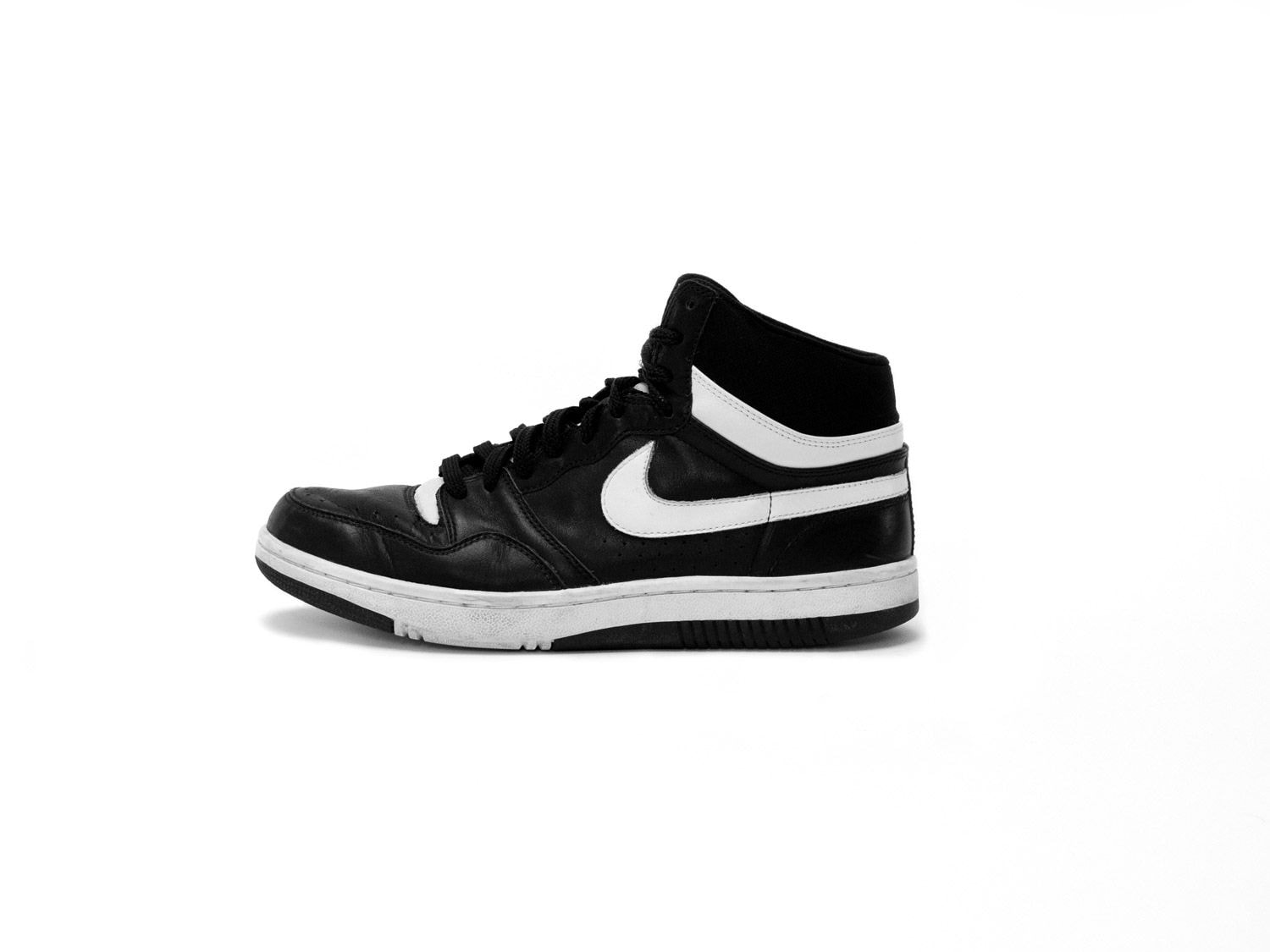
Following all the experimentation of the HTM line, the decision to drop the Court Force in a quartet of colorways was something of a surprise. After all, this 1987 mid-priced basketball shoe was hardly as hyped during its heyday as other models on the shelves. What the Court Force had on its side was reappropriation – skaters took to this model for a brief moment in the 1980s, with legends like Eric Dressen and Hiroshi himself putting a pair through its paces in a decidedly off-court setting. It was this emotional connection that instigated a resurrection.
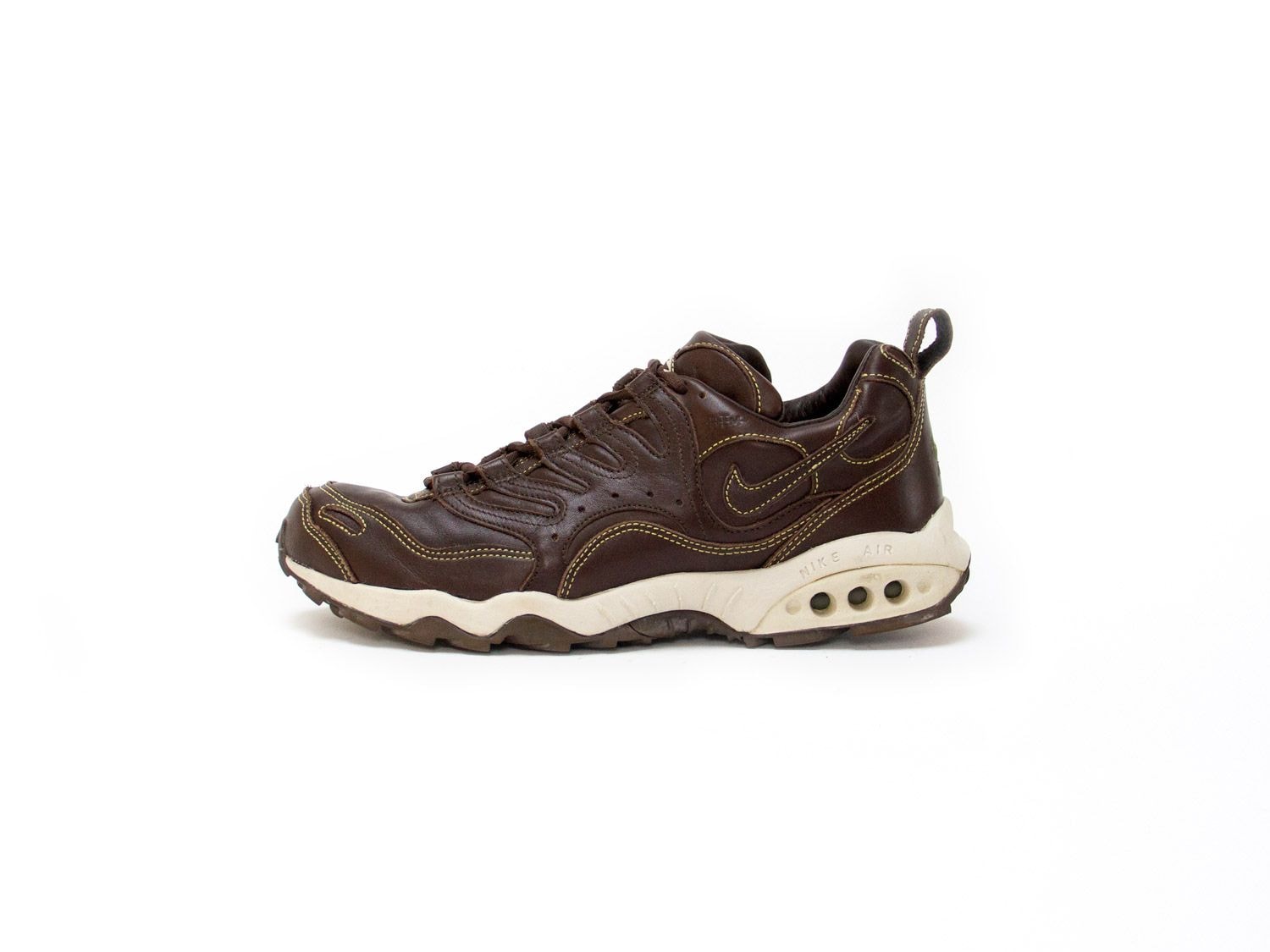
To accompany the leather and accentuated stitches of the Air Force 1, the HTM Terra Humara turned the 1998 design by Peter Fogg – a legend for trail-shoe disciples – into something significantly more premium. As part of Hiroshi Fujiwara's first Nike project – the co.jp (Concept Japan) Monotone collection – the Terra Humara made sense. Profiled by Vogue around the time of its original release, the shoe was no stranger to the spotlight, with the right mis of odd and conventional features to make it a cult classic.
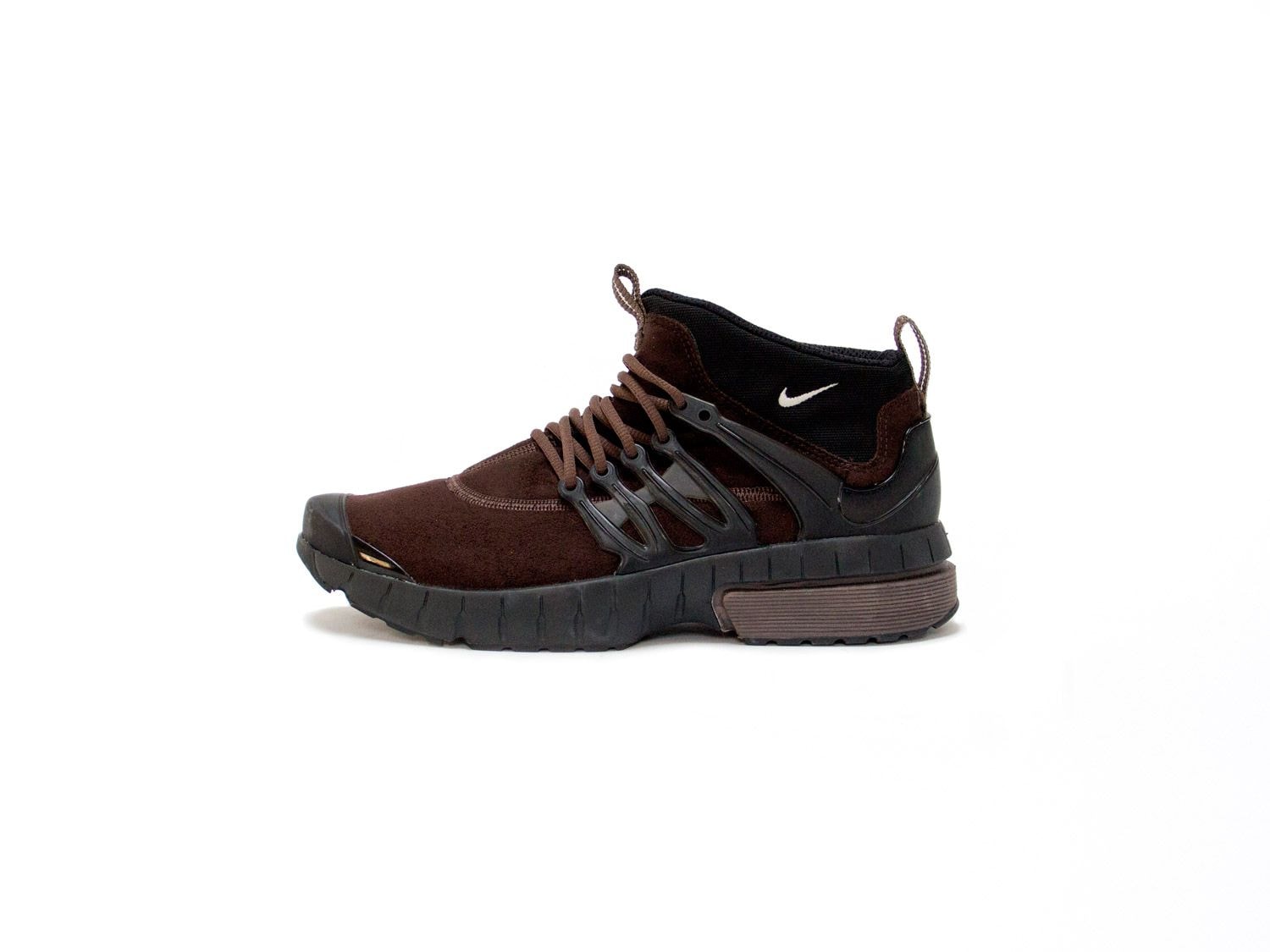
When the Presto debuted in 2000, it got Hiroshi Fujiwara's cosignature from the start. The HTM Presto Roam was early evidence that HTM was going to be more than just new colors and materials – it would be a test bed for new silhouettes entirely. Presto's sock-like fit spawned a dynasty that includes the Presto Cage, Gym, Ridge, Glide, Faze, Clip, Chanjo, and Tent. The Roam is a trail-take on the technology that switched stretch neoprene to suede and upped the collar for protection, akin to the 1991 Tinker Hatfield-designed ACG Air Mowabb. Non-HTM editions appeared too, albeit in less memorable make ups.
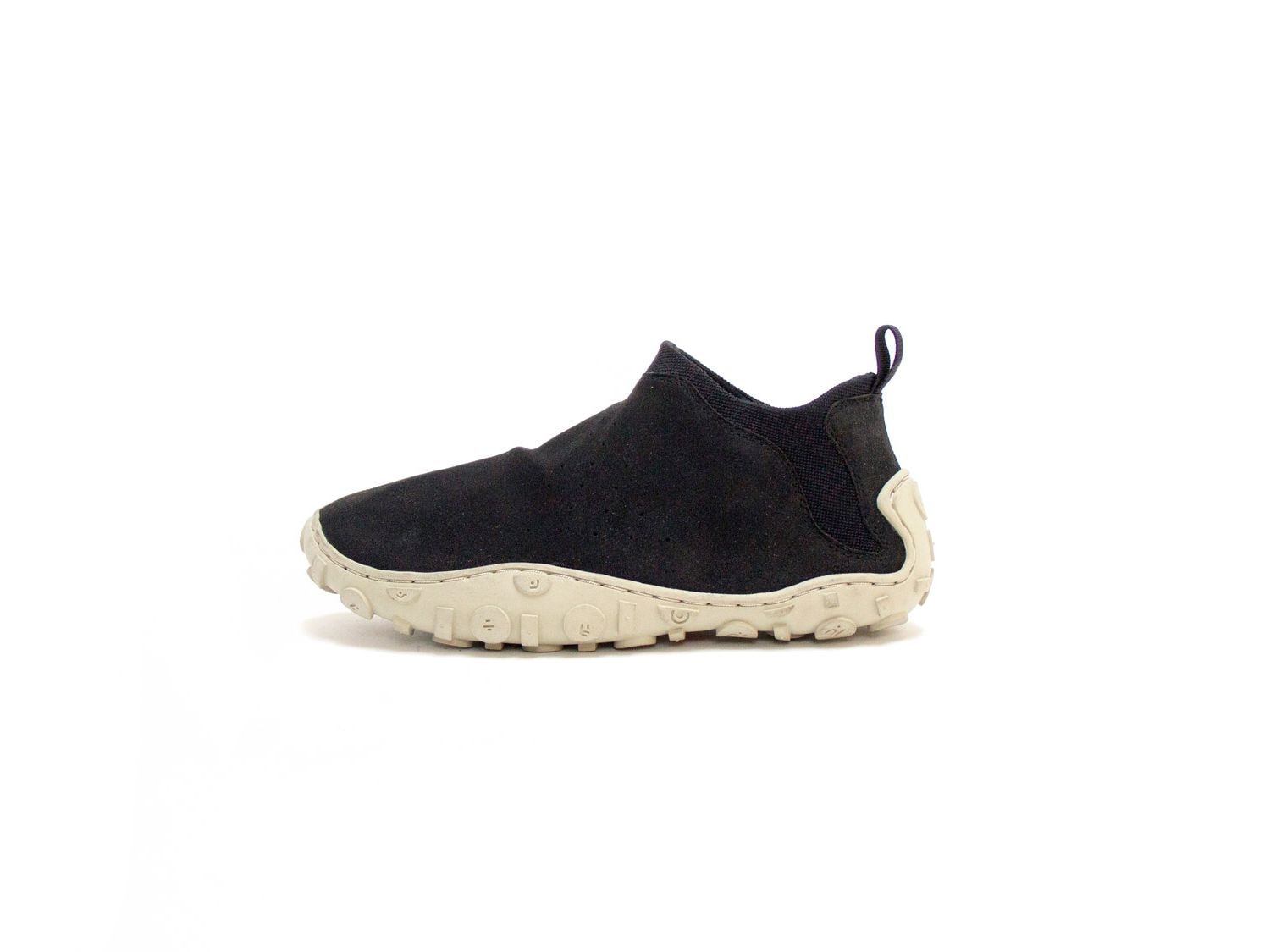
The Nike Air Moc represents Nike's ACG division at its most eccentric. Potato comparisons aren't unfounded, as the perforations were inspired by fork piercings, and a supposed working title of the model was Air Ida (after Ore-Ida company, a near century-old purveyor of potato products). In 1994, this shoe found a loyal audience with outdoor types and an open-minded Japanese connoisseur crowd. Having dropped in a variety of heights, colors, and fabrics, the Nike HTM edition was a mid-cut with extra grip and a Chelsea boot-style stretch panel for easier wear.
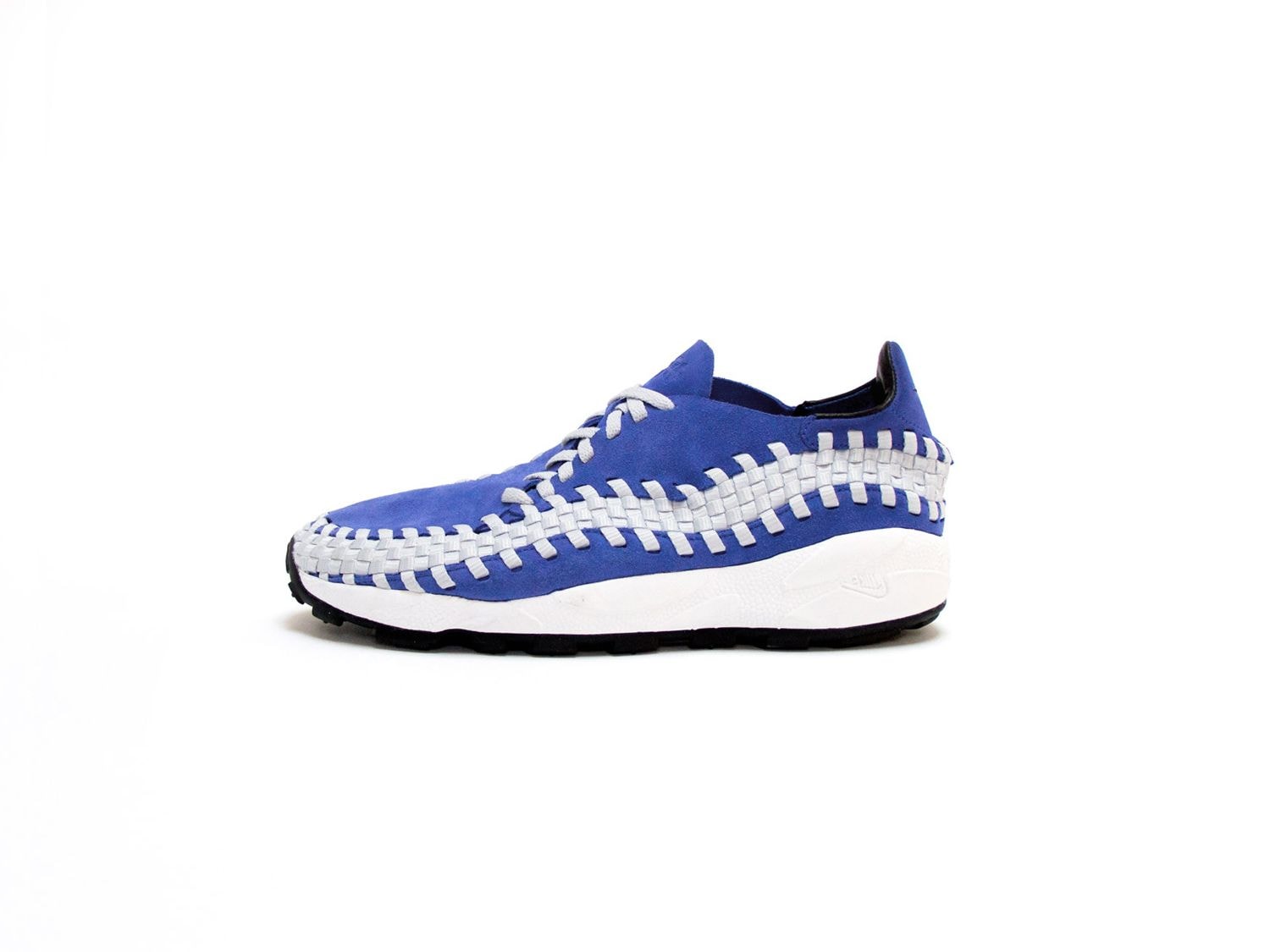
Combining two past oddities – the 1995 asymmetrical fastening, foot-shaped Footscape Woven is a little more accessible than its predecessors. The model, which is hard to obtain because of its frugal numbers and distribution, was the starting point for a rollout of World Cup-themed editions and further collaborations, including the appropriately oddball pony-skin variations made with the legendary London store The Hideout.
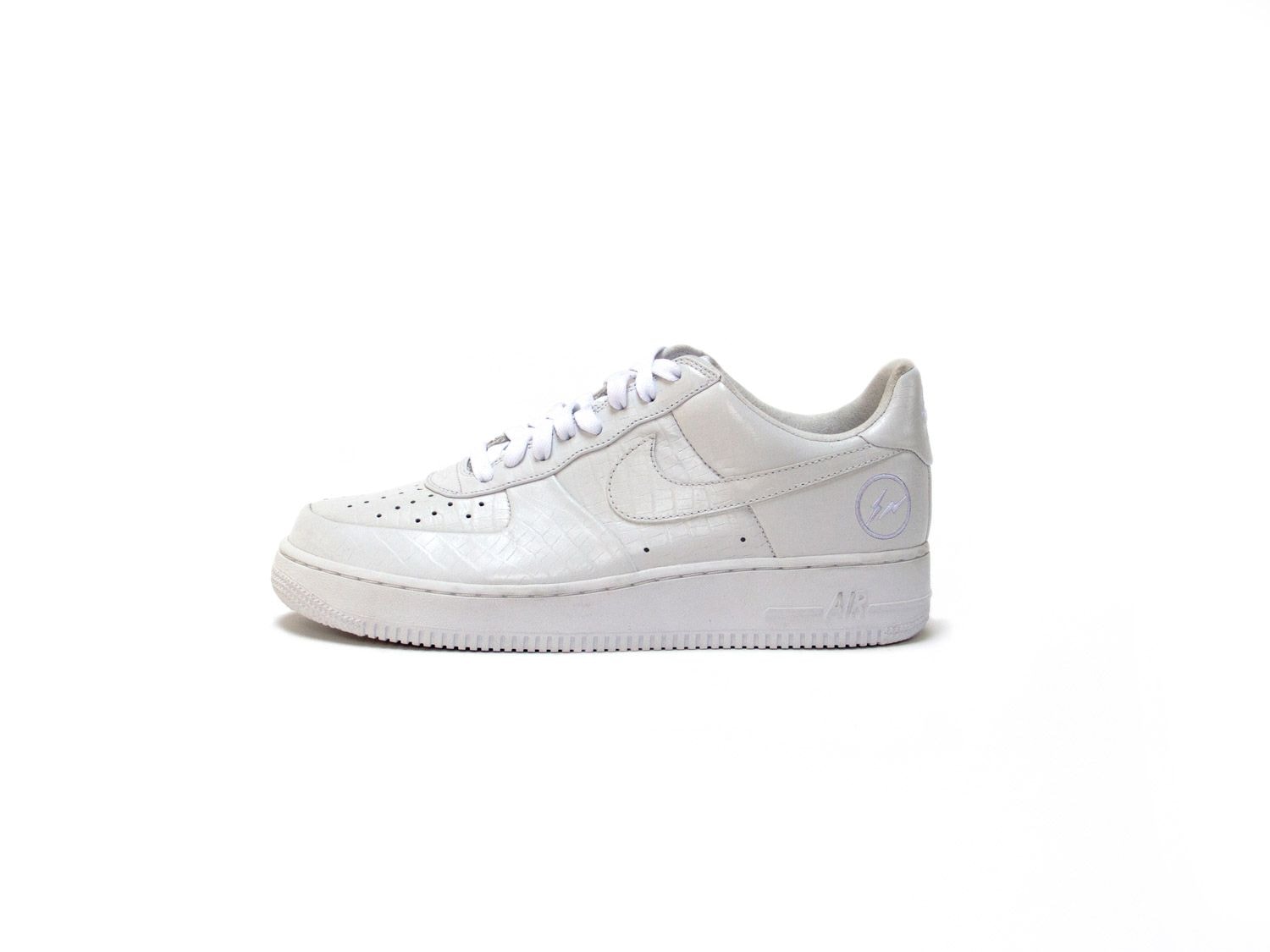
Twenty years after the Air Force 1's debut, this shoe represents the start of the HTM project. It's tough to understand how something so simple could be revolutionary, but the original double release in black and brown versions of a staple – some with contrasting stitches – demonstrated how effective highlighting the construction of a classic can be. Each individually numbered pair came in custom slide-out boxes. They were only ever distributed to a handful of boutiques around the world, and by the time a new wave of connoisseurs and collector's realized they needed them, they were gone. *Shown here is actually the 2008 HTM Air Force 1 Fragment Reissue
The Solutions
The first two HTM designs, both released in 2002, were rooted in the 1980s. Reissueing classics in new materials and colors, the Air Force was made in black and white crocodile, and the leather Court Force was revamped in several new colors including two shades of blue, brown, and black. While these are strongly connected to Fujiwara’s roots in skateboarding and hip-hop cultures, I wondered out loud how they would have satisfied Hatfield’s drive for technical innovation. Hatfield’s response: “That wasn’t really lighting my fire or Mark’s fire, because we saw the opportunity to do something different that promotes newer ideas, rather than just color or material changes.” The group moved on: these were the first and last reissues HTM produced.
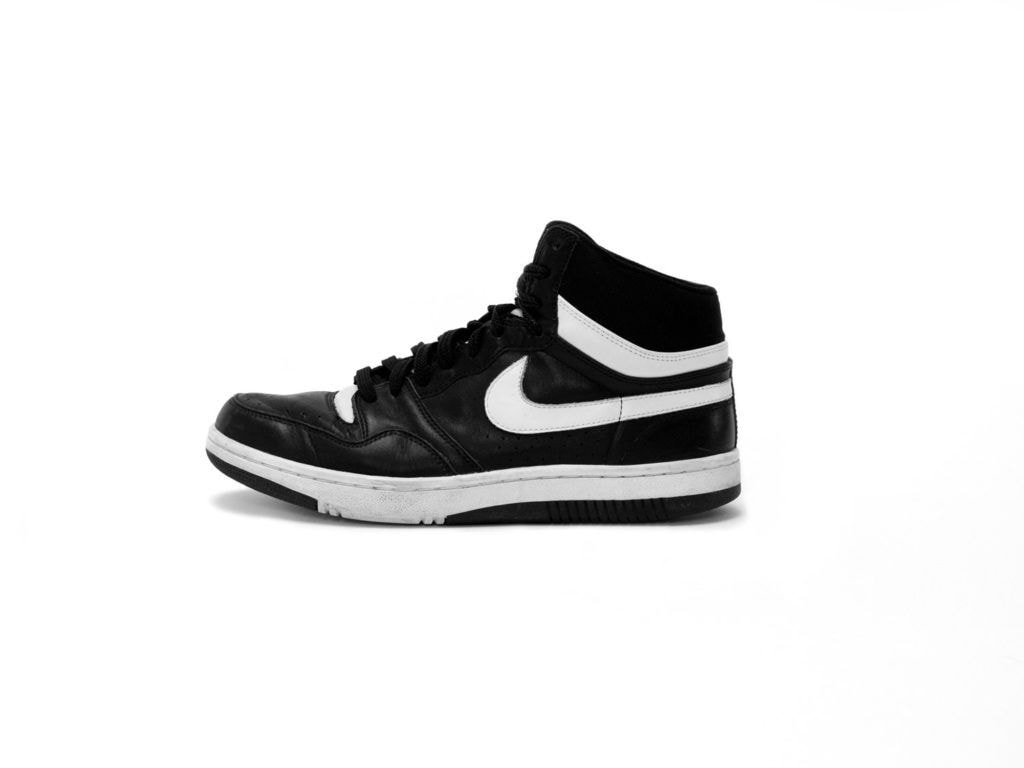
Where the HTM Air Force and Court Force looked to the designers’ pasts – particularly Fujiwara’s – the next series of HTM designs were firmly rooted in their current lives. Pairing performance-driven features from Nike’s archive with elements of traditional and formal men’s shoes, the next three HTM designs are disntinctly grown-up. These designs want to be worn to meetings and dinners, and were devised to explore terrain where the purely sports-centered sneaker might lack sophistication. The first in this series was the HTM Air Moc Mid, which was based on the 1994 Air Moc, a one-piece moccasin with a pull cord that tightens around the ankle. HTM’s 2002 redesign is simple, replacing the sporty textile of the upper with suede, and the pull-cord at the ankle with elastic siding, which conjures the image and spirit of a Chelsea boot. Another design in this series is the 2003 Air Presto Roam, an adaptation of Nike’s 2000 Air Presto. In the redesign the stretch fabric of the original midsole is replaced with black, brown, or beige suede, and the height of the shoe is extended, giving the look and extra support of a boot. An added rubber toe protects the shoe from wear, and a frontal pull tab, also in the style of a Chelsea boot, offers convenience and elegance.
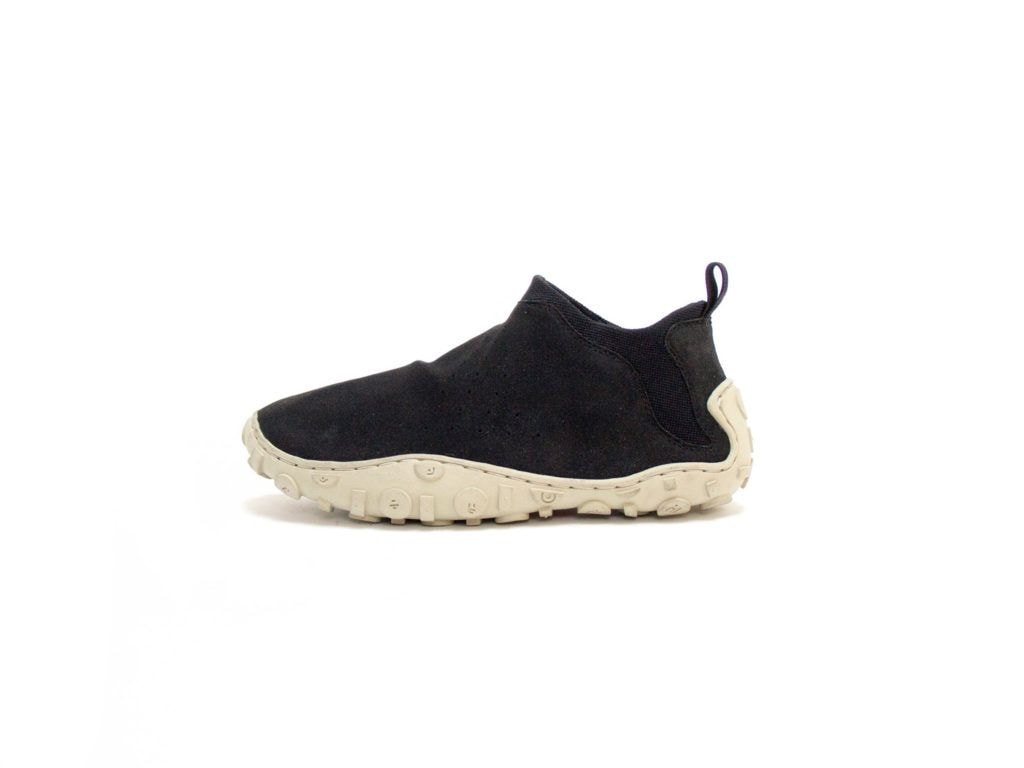
With the HTM Zoom Macropus the group launched their first shoe designed entirely from scratch. That being said, the design took inspiration from another 1960s classic; the Clark Wallabee. The Macropus was released in 2003 in horsehair, suede, black leather, and a “furry” black upper. The name Macropus alludes to the species Macropus Wallaby, commonly known as the Eastern Gray Kangaroo, from which the namesake of the Clark Wallabee was derived. This name also hints at Mark and Tinker’s relationship with the taxonomy, evolution, and natural species that feed into many HTM designs. “We’re so familiar with the taxonomy of our own shoes and shoes in general, so references there are quite natural,” Parker stated after I brought up the historical associations that many HTM models carry. As comfortable as the trio is with the past, the real glory at Nike is on the future frontier, which is where the third, and most radical series of HTM designs have been blazing trails. A succession of avant-garde designs – the HTM Air Woven Rainbow, HTM Air Footscape Woven, and the Flyknit Series – combine ancient shoe technology, early-1980s Nike experiments, and computer controlled knitting to redefine shoe construction for the 21st century.
The Evolution
During a 1938 archaeological dig in Fort Rock Cave, Oregon (250 miles southeast of Nike’s headquarters), the anthropologist and sociologist Luther Cressman discovered the oldest known shoes, a pair of 10,000-year-old sandals. Handwoven from shredded sagebrush bark into a continuous one-piece sandal, the construction of this shoe differs radically from the cut-and-sew assembly that has dominated modern shoe design. The designers at Nike are very familiar with this discovery, and some even knew Cressman himself, Hatfield perhaps more than others: “I drew a picture of that old shoe for him, that he actually got framed, and it’s one of the few things he and his wife kept when they moved out to Eastern Oregon to live out their final days.”
“There’s no pressure to fit some schedule, it happens when the impulse is there.”
The ancient design helped Tinker question the basis of 20th-century shoe construction: “The Industrial Age created all these modern materials that you could cut up and use, but before that you actually had to weave stuff together.” Cressman’s discovery germinated the idea that a one-piece, single-structure shoe was possible with newer technologies. While HTM has played a substantial role in reaching this goal, the pursuit of it began at Nike long before HTM got started.
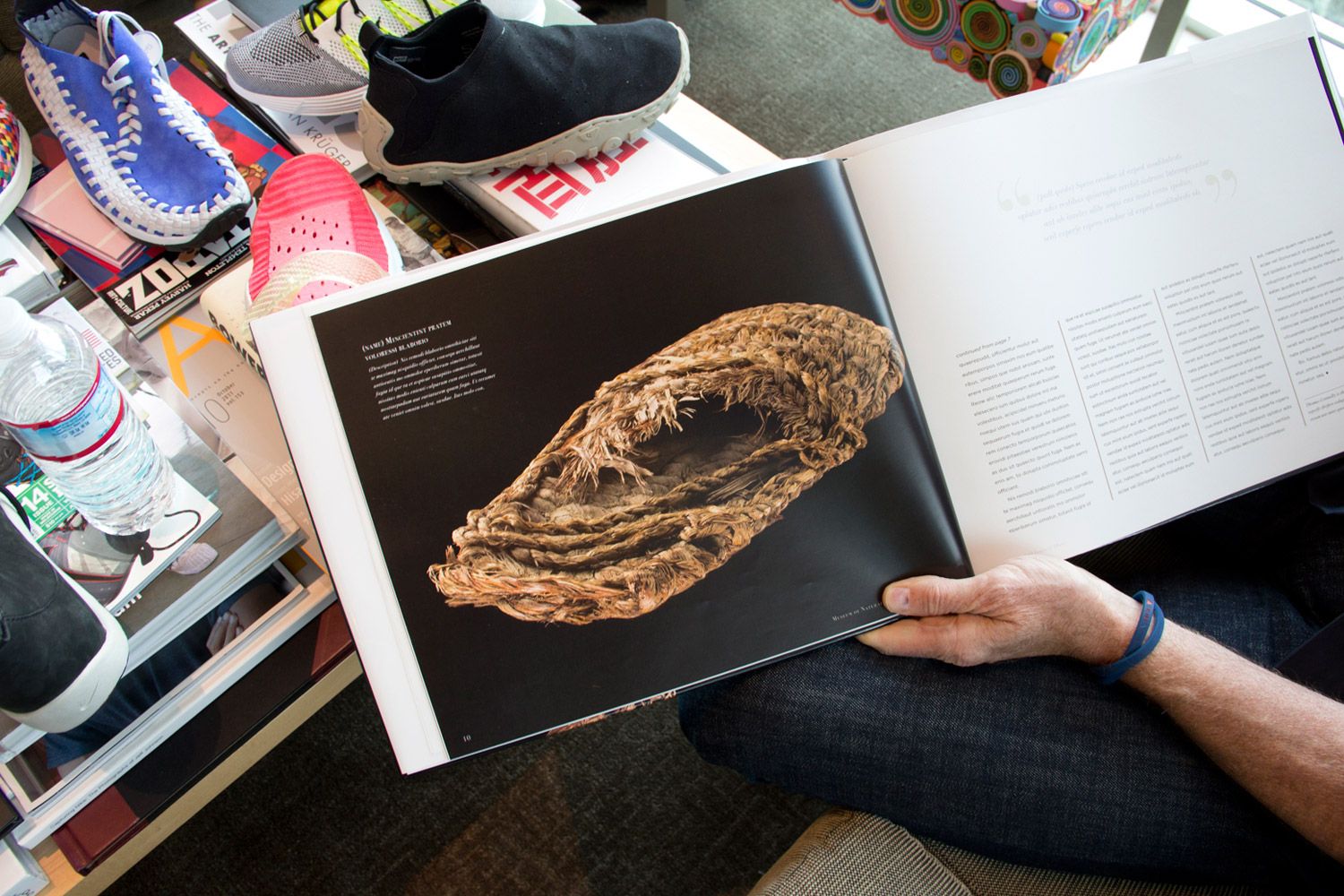
The first step in this process was the 1984 Sock Racer. Made with a bright yellow sock and two black textile straps, the design still looks radical today. Though the sneaker was functional (Ingrid Kristiansen won the 1986 Boston Marathon wearing a pair), the shoe’s unconventional fit and appearance was only marginally accepted by the market. At Nike marginal success doesn’t constitute failure; it is central to the brand’s design culture and growth. Discussing Nike’s design archives, Parker pointed out that, “There are more things that didn’t make it littering our path than things that did, and the ability to leverage some of that and build on it is part of the design process.” Seeing the potential in the often crude results of costly experimentation is a quality that sets Parker apart from the typical CEO. Therefore it’s not so surprising that Nike picked up on the sock idea again in 2004 with the Sock Dart (not officially an HTM model but certainly bearing a genetic resemblance).
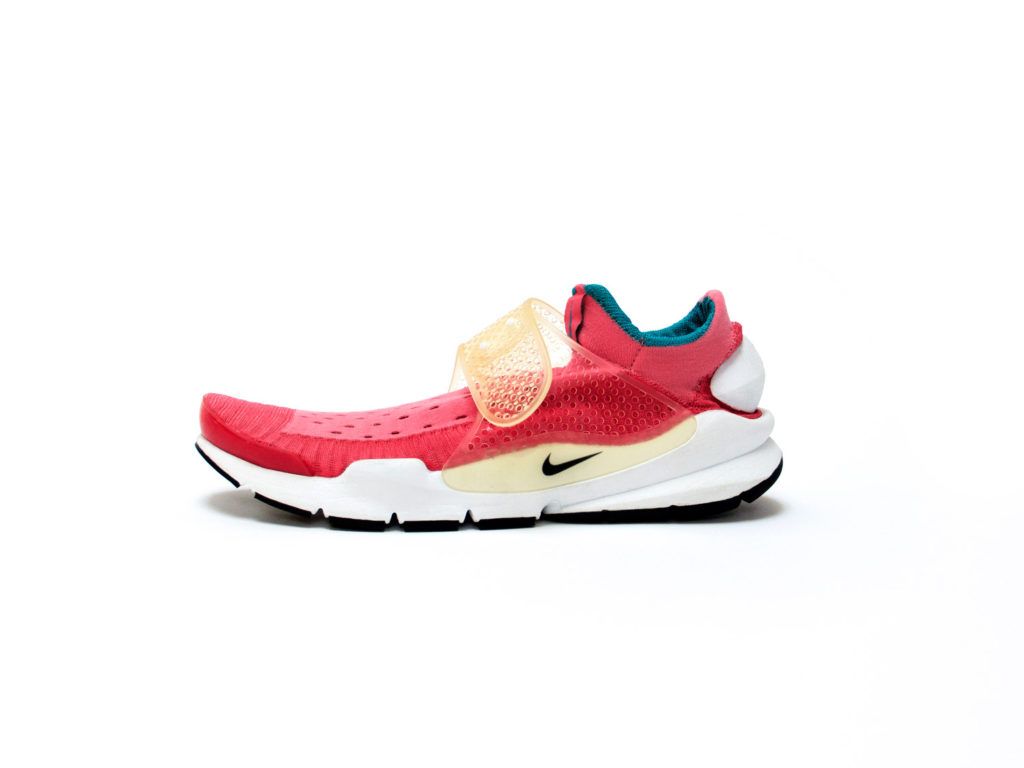
The Sock Dart was the first-ever shoe made with computer-controlled knitting, a technique that allows a single textile to be knit with varying densities, characteristics, and colors. Though this sock is an early and flat rendition of the technology’s potential, today it stands out as a beta test for the far more advanced 2012–13 HTM Flyknit series. Like the Sock Racer, the Sock Dart also featured a strap, but this time the material was a floppy, transparent silicone. The shoe is even stranger looking than its 80s predecessor, and while only marginally embraced, this time around the project was conceived as a limited edition from the beginning. “That’s another one of the beauties of HTM,” Parker points out, “we aren’t encumbered by the sheer magnitude of the numbers.” In the design process, knowing what doesn’t work can be as important as knowing what does. The repeated use of straps proved that sock technology didn’t provide sufficient support on its own, and prompted a search for more elegant structural solutions. While the lack of structure was the only thing standing between Nike’s sock experiments and the one-piece shoe they were pursuing, a parallel design process in weaving was making some headway. The entire upper of Nike’s 2000 Air Woven is woven from nylon strands without the use of a last, allowing the weaver to loosen or tighten the weave to determine the shoe’s size. While the original design draws on Mexican huarache sandals, the extreme coloring in HTM’s 2002 redesign took its inspiration from pixels. In HTM’s version each nylon strand is dyed in several colors, making each visible square in the weave a different color. While the Sock designs were awkward, the Woven made great aesthetic progress – “those shoes were in the movie Lost in Translation (2003)” – Parker said. “Bill Murray wore a pair in the film.” But the design still suffers structurally. Limited by the consistent width of its strands and the perpendicular nature of weaving, the Air Woven lacks the form-fitting support of the traditional cut-and-sew build. A second design in 2005, the HTM Air Footscape Woven, gained additional support by combining the woven areas with patches of suede. At this point the only short coming in the weaving process was the cost, as it is a hand operation. While one-piece aesthetics and structure were being proven in the Woven series, technological progress was underway in computer-controlled knitting. In 2008 Parker’s nose for potential in crude form picked up on developments that would allow Nike to revisit their sock experiment for the third time. “A lot of the early knit shoes were actually quite ugly, and they were sitting on the corner of somebody’s desk, and that’s what I love to do, walk around and go, ‘What is that?’” Work on the knit-sock had continued in Nike’s Innovation Kitchen, and Parker was quick to “give it more energy, support it, and put it on a higher priority.” Speaking of the succession of HTM models, and the progress that occurred between them, Tinker stated: “There is an editing process, which I believe all good designers do. You go out further than you really should, but it’s a great process. Then you edit and get back to the essence.” After four years of development, in 2012, HTM launched the Flyknit Racer and Flyknit Trainer+. Through development of the computer-controlled knitting process Nike finally achieved its goal of an aesthetically resolved, structurally supportive, and lightweight one-piece shoe.
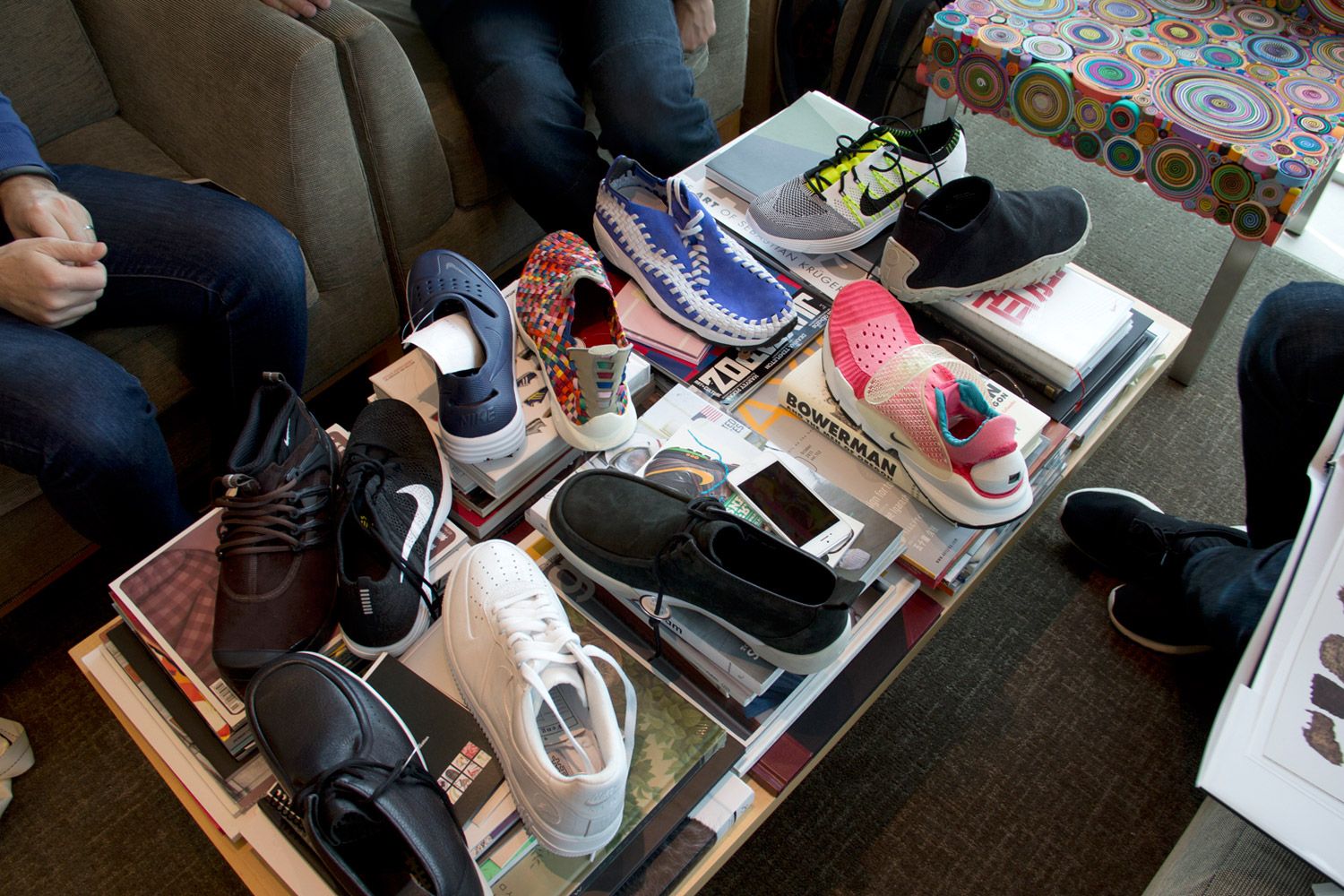
Taking engineering methods used to knit sweaters and applying them to sneakers is one of the more suprising examples of HTM’s unconventional practices. Designer Errolson Hugh of the techwear brand Acronym considers Flyknit one of the best cross-pollinations in the industry today. “When I speak to knitwear engineers and designers about Flyknits, they’re fascinated. Knitting itself is an incredible discipline, inherently technical, and so rich in tradition and culture. So Flyknit has really surprised a lot of people. It’s taken the entire field and pushed it into new territory,” Hugh says. “It’s one thing to have an idea, but it’s another to execute it and roll it out at the level that Nike has. It looks effortless now, but you know it had to have been everything but.”
“Asked about the Nike resources at HTM’s disposal, Parker shrugs, “Whatever we need.”
The knitting process in the Flyknit series achieves such accuracy and variability that the design of the shoe all happens at the textile level, where, according to Parker, the user gets “only what you need where you need it.” In place of the clumsy strap used in the Sock Racer and Sock Dart, Nike developed Flywire, a structural thread that is inserted into the knitting to add strength without increasing weight. Fujiwara points out that “when you first look at it, it looks simple and orthodox, but when you look closely, you see the detail of this new technology.” In 2013 HTM launched the Flyknit Chukka, a taller cousin to the Racer and Trainer+, and since the launch of the HTM Flyknit series, the technology has been adopted in several Nike running shoes.
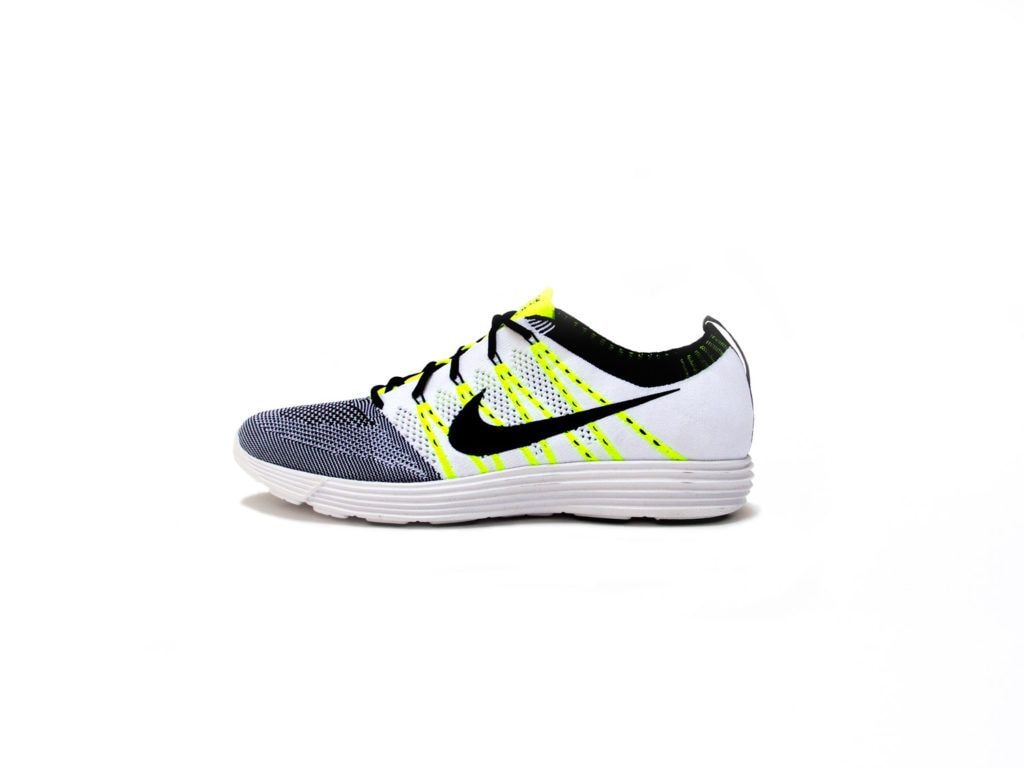
Unlimited Editions
In our time, limited edition is defined by what it’s not: unlimited, or mass-produced. The next wave of computer controlled, additive manufacturing will change how we define these terms, as the two converge. “You will see more and more exotic shapes and materials because we don’t necessarily have to make moulds anymore.” Mark was discussing the advantages of 3D printing, which Nike recently used to make the Vapor Laser Talon, a pair of American football cleats. The plate of the Talon is printed using Selective Laser Sintering (SLS), where a laser fuses particles of material, layer by layer, into the desired form. Characterized by a repeating vaulted geometry that results in a 5.6 oz, ultra lightweight construction, the Talon’s plate would be impossible to make using traditional moulding processes. 3D printing does away with many old manufacturing constraints; laborious details and challenging geometries are easier to make, and small batch production gets less expensive. While 3D printing has become popular for its use in the production of prototypes and one-off novelty items, it is presently used by several industries to produce hard-to-make or out-of-production components. Boeing and Airbus are producing aircraft parts in alloys and plastics, the healthcare industry has made custom plastic hearing aids from 3D scans of their users’ ears, and the 3D printing industry regularly makes components for its own printers. Currently, slow speed and high material cost prevent 3D printing from being suitable for low-cost mass production, but the technology is improving yearly, and Nike’s cleats are an early example of printed products for the consumer. In addition to revolutionizing how we construct things, 3D printing promises to take prohibitive tooling costs and minimum orders out of the way for cash-light startups and big business alike. Ultimately, what will distinguish corporation A from startup B is the quality of the goods they purvey, which is a matter of design, not technology. “The role of design at a company is to allow you to recreate yourself,” Parker says, “to allow your company to find a new way of success before the old way fails.”
Text and Photography by JONATHAN OLIVARES, with additional reporting by GARY WARNETT
